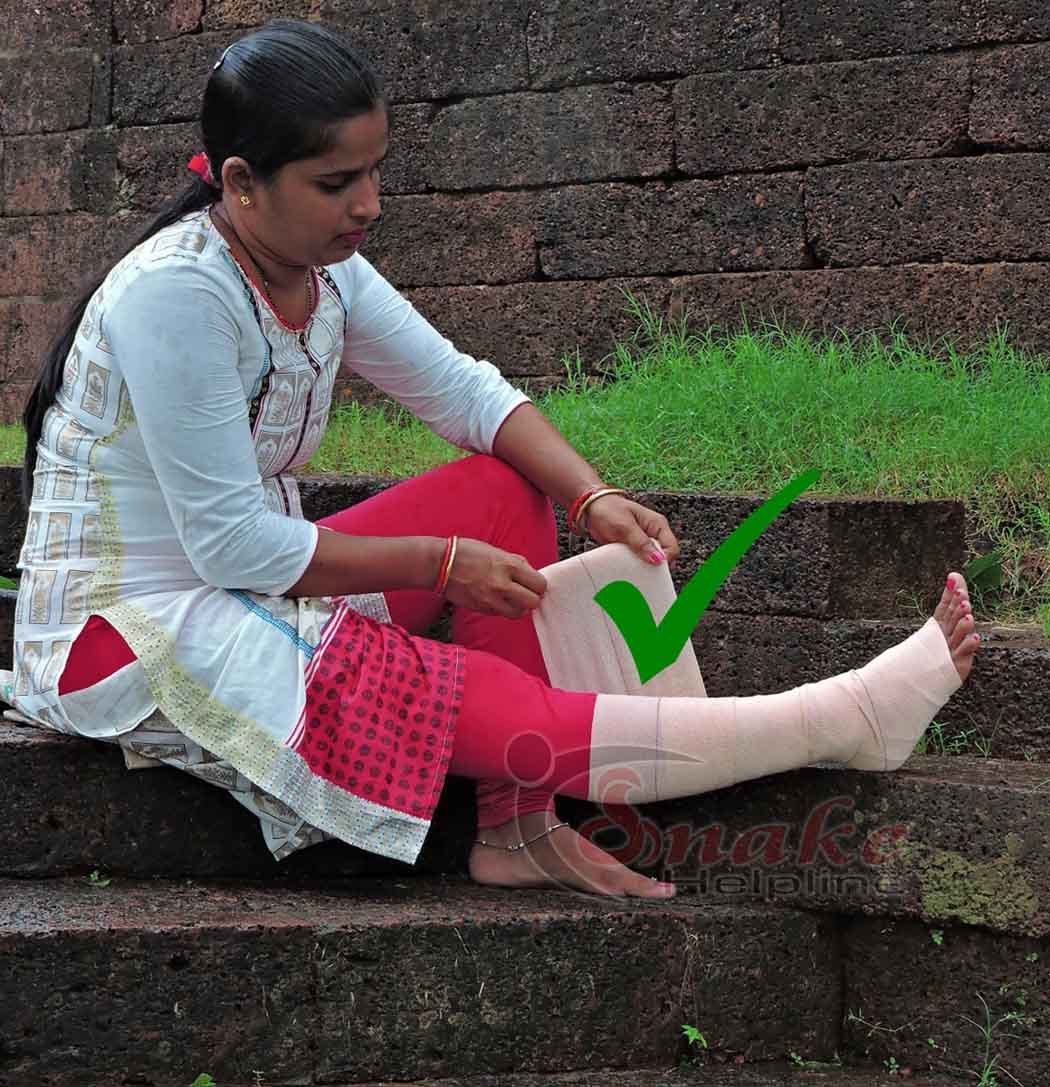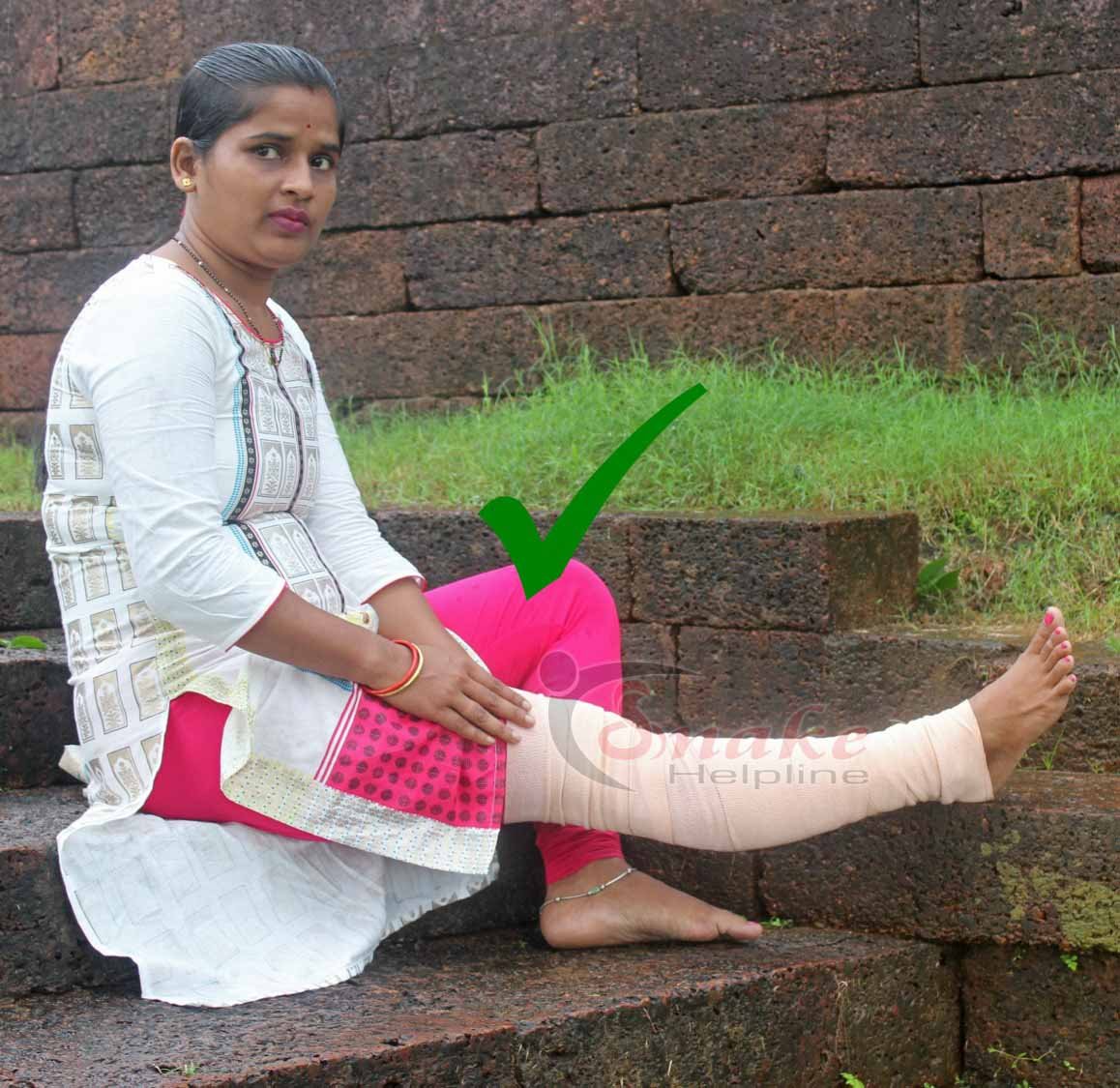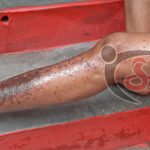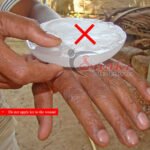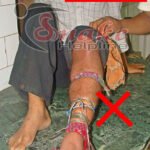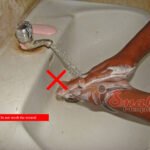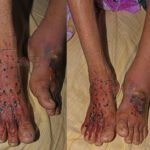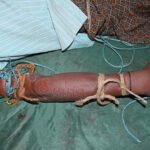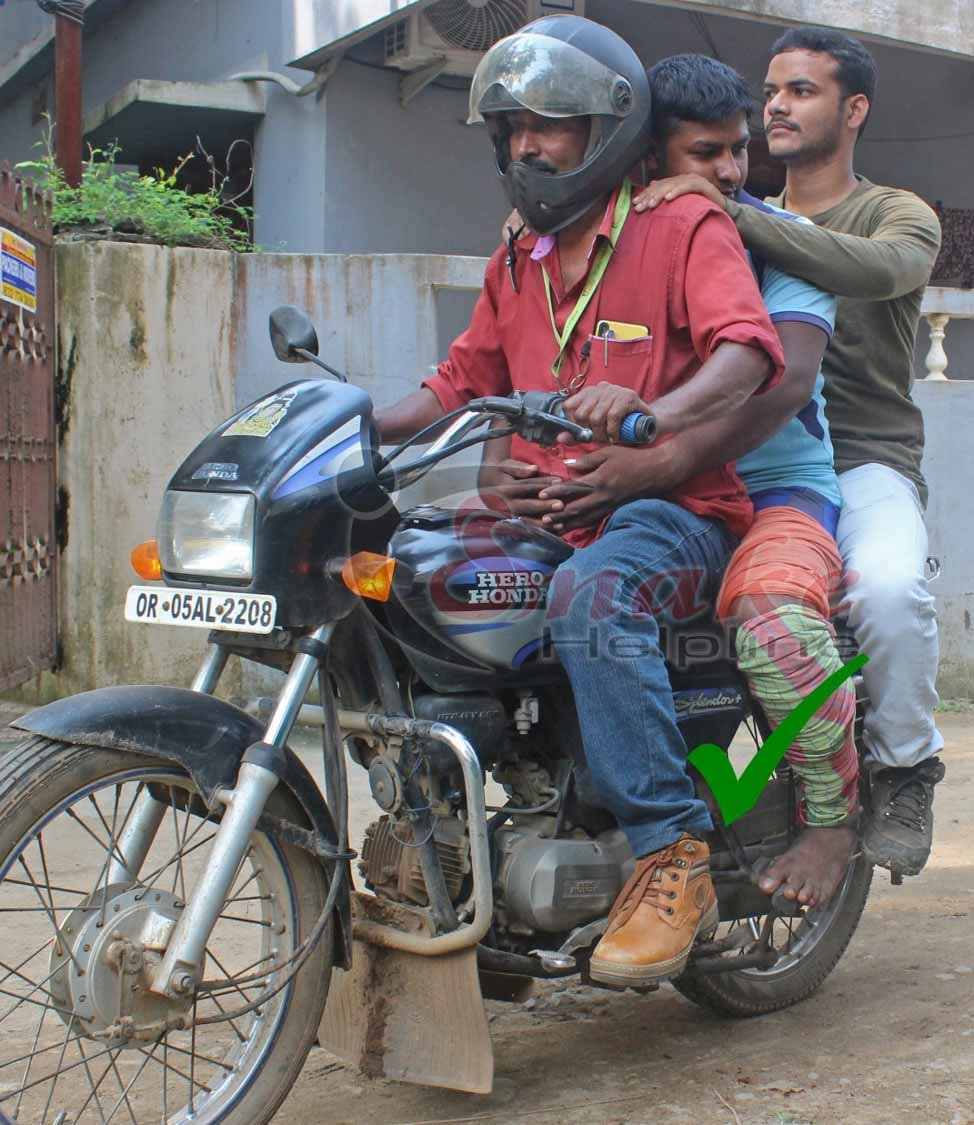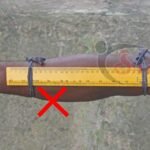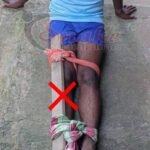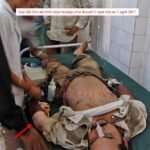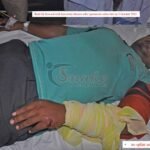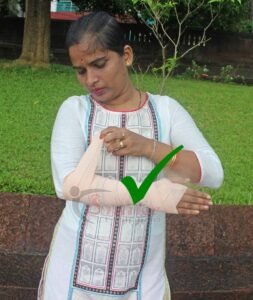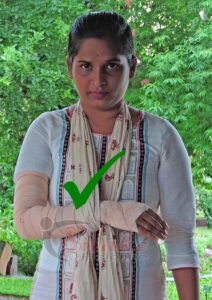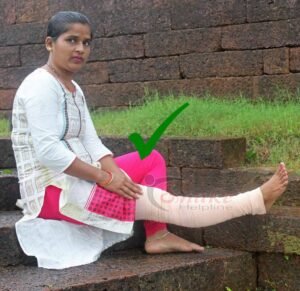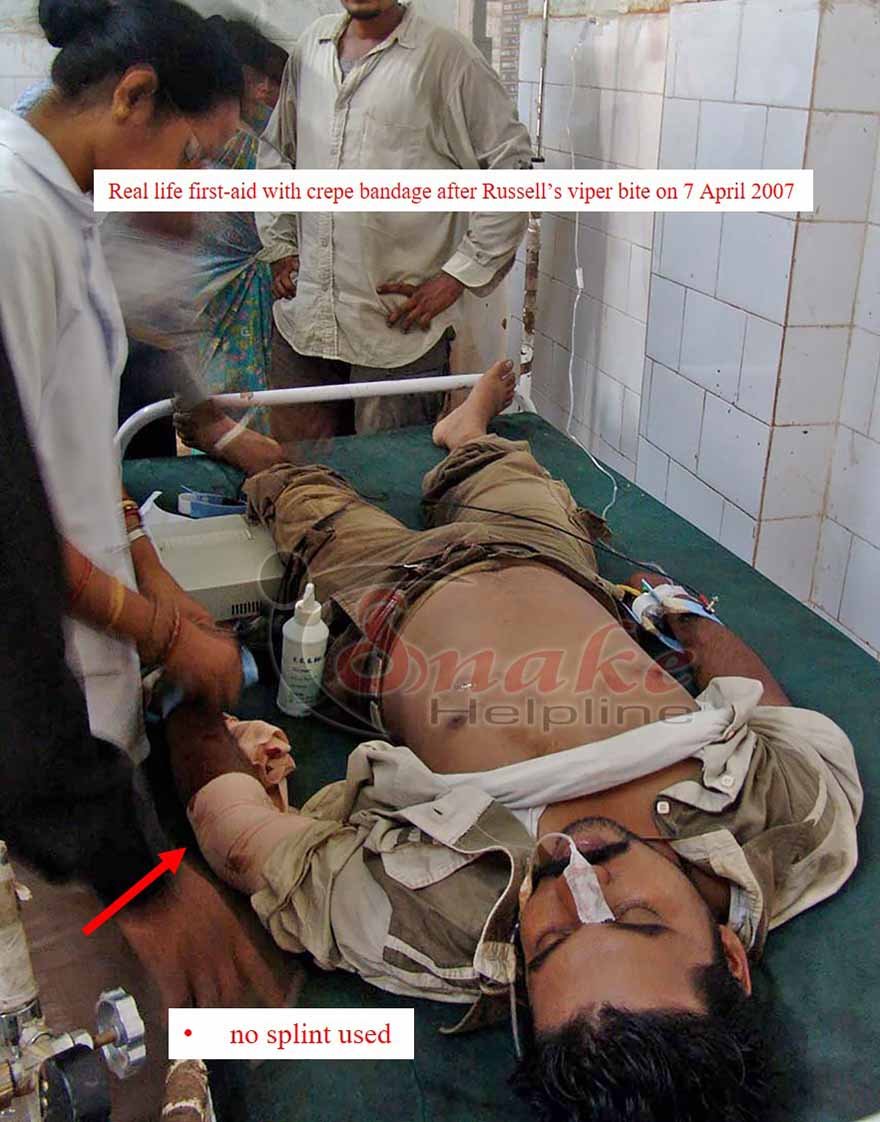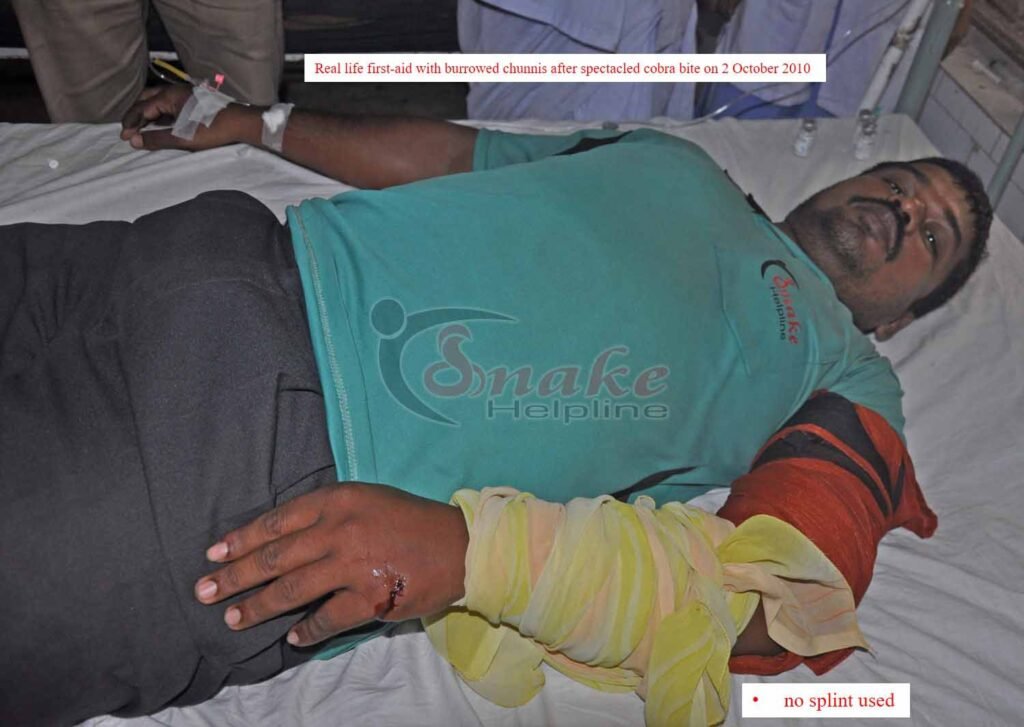

As per the ‘WHO Guidelines for the Management of Snakebites 2016’ the Principles of the First-aid treatment
✓ First-aid treatment is carried out immediately or very soon after the bite, before the patient reaches a dispensary or hospital.
✓ It can be performed by the snakebite victim himself/herself or by anyone else who is present and able.
Aims of First-aid should be –
✅ Reassure the snakebite victim
✅ Attempt to delay systemic absorption of venom.
✅ Preserve life and prevent complications before the patient can receive medical care at a dispensary or hospital
✅ Control distressing or dangerous early symptoms of envenoming
✅ Arrange the transport of the patient to a place where they can receive medical care
DOs in case of snakebite:
✓ Give consolation to the victim. 70% of all snakebites are from non-venomous species. Only in 50% of bites by venomous species venom is actually injected; rest are ‘Dry bites’ where no venom is injected.
✓ Remove all the ornaments and other constricting materials present on the bitten limb.
✓ Use a broad crepe/elastic bandage to wrap lightly towards the upper proximity of the wound. If such bandage is not available, need not worry. Any available long cloth like towel, chuni, etc. can also do the job.
✓ Get to the nearest hospital where the snakebite treatment is available. Traditional remedies have NO PROVEN benefit in treating snakebite.
✓ On reaching the hospital tell the doctor of any symptoms that you observed (vomiting/ptosis etc.) on the way to hospital.
Further -
✅ The snake, if killed should be carefully taken to the hospital for identification by the doctor.
✅ A full body photograph of the dead or alive snake can also be taken to show it to the doctors.
✅ No time should be wasted in attempting to kill or capture the snake. This solely wastes time and can lead to other victims.
DOn'ts in case of snakebite:
 Do not panic.
Do not panic.
 Do not allow victim to run or any work.
Do not allow victim to run or any work.
 Do not use tourniquets: The use of tight tourniquets made of rope, belt, string, electric wire or cloth have been traditionally used to stop venom flow into the body following snakebite. They actually do MORE harms and NO goods.
Do not use tourniquets: The use of tight tourniquets made of rope, belt, string, electric wire or cloth have been traditionally used to stop venom flow into the body following snakebite. They actually do MORE harms and NO goods.
 Do not apply any herbs to the wound.
Do not apply any herbs to the wound.
 Do not wash the wound.
Do not wash the wound.
 Do not apply cut suction to the wound; it worsens the condition. No venom is removed by sucking the wound. Mechanical suction devices are also of NO use.
Do not apply cut suction to the wound; it worsens the condition. No venom is removed by sucking the wound. Mechanical suction devices are also of NO use.
 Do not apply ice to the wound.
Do not apply ice to the wound.
 Do not make any incision to the wound site or any other body part.
Do not make any incision to the wound site or any other body part.
 Do not drink alcohol.
Do not drink alcohol.
 Do not apply acid to the would or bitten limb
Do not apply acid to the would or bitten limb
 Pressure Immobilisation Method (PIM): Although Pressure Immobilisation has gained some supporters on television and in the herpetology literature. It is banned in India since 2007.
Pressure Immobilisation Method (PIM): Although Pressure Immobilisation has gained some supporters on television and in the herpetology literature. It is banned in India since 2007.
Transport of the snakebite victim:
– Do not waste precious time for waiting for the ambulance to arrive at the spot.
– Arrange any means of transport that is available nearby.
– Prevent victim from running, instead walk gently to the transport mean.
– If transporting on a two Wheeler, make it sure that the fees of the victim is on the foot-rest. Or else if the leg descends down, it will cause further injuries due to friction on the road.
– In the case of fainting or any neurological manifestation, a rider must be there behind the victim to support from falling and making the bike imbalance.
Do the use of wooden splints helpful/necessary for India?
Many guidelines and literature advocate to use a wooden splint to immobilize the bitten limb; however, there is no supporting evidence available for the use of a wooden splint in first-aid after snakebite. The use of a wooden limb first came to light after the publication of the article “Rationalisation of First-aid Measures for Elapid Snakebite” by Sutherland et al. (1979) in the mega journal Lancet. The concept of Pressure Immobilization Method (PIM) thus started by Sutherland et al. (1979); that article continued to encourage many to advise the use of a wooden splint. That article is freely available in the Wilderness and Environmental Medicine 2005, 16(3): 164–167 in Lessons from History. However, Rogers & Winkel (2005) in Wilderness and Environmental Medicine; 16(3): 160–163 criticized the article of Sutherland et al. (1979) and found many lacunae in their research.
Serious drawbacks in Sutherland et al. (1979) pointed out by Rogers & Winkel (2005)—
- They would surely have difficulty in the Ethics Committee level in receiving the necessary approval to conduct such a study on non-anesthetized monkeys.
- Selective reporting of the results: 25 monkeys were studied, but presented the results for only 11; the reason for this selective reporting is not stated.
Our comment – Selective reporting or suppression of data amounts to falsification of data. As per the BMJ (British Medical Journal), ‘Falsification of data’ is a form of ‘Scientific Misconduct’ that includes deceptive selective reporting of findings and omission of conflicting data, or willful suppression and/or distortion of data. Therefore, with proven scientific misconduct Sutherland et al. (1979) article is unreliable, even though published in a very big journal.
Several researches were conducted on the application of Pressure Immobilization (PI). Bush et al. (2004) researched with 20 pigs and concluded that PI should be discouraged for bites that involve venoms that produce substantial local injury. Norris et al. (2005) found that not only lay people but also physicians were unable to apply PI properly. Simpson et al. (2008) found that training did not increase the ability to apply PI in simulated snake bite.
The PIM was rejected with sufficient logic in the ‘Draft Summary Protocols Snakebite Prevention Snakebite First Aid and Treatment Support Concepts’ held at Indian National Snakebite Conference 24 & 25 July 2006 Amrita Institute of Medical Sciences Cochin, Kerala. The Indian National Snakebite Conference Protocols 2006 clearly stated “For the above reasons. Pressure Immobilization is not for the use in India” in bold letters in the P.7. After the publication of the ‘Indian National Snakebite Protocols 2007’ the people of India were somehow restrained from using PIM. However, the PIM was included with an illustration in the Fig. 2, P. 10 of the Standard Treatment Guidelines (STG) Management of Snake Bite Quick Reference Guide January 2016 even though it was placed in “important don’ts”. The same was subsequently published in P. 9 with an illustration (Fig. 2) in the STG Management of Snake Bite August 2017 by the Ministry of Health & Family Welfare, Government of India.
The STG-2017 further stated that the Pressure immobilization (Sutherland method) may be applied by qualified medical personnel only till the patient is shifted to the hospital; if trained personnel is not present, Do Not try. This is not at all in agreement with the Indian National Snakebite Protocols 2007 which imposed outright ban on the PIM (Sutherland method). This is not going to work, as Norris et al. (2005) proved that even doctors who are the best qualified medical personnel also failed to apply PI correctly. The STG-2017, therefore is far from clarity in the first aid management by glamorizing the PIM (Sutherland method) that has been banned since long in the Indian National Snakebite Protocols 2007. Thus, the STG-2017 is actually misleading, because world famous experts on snakebite like Bush et al. (2004), Norris et al. (2005), and Simpson et al. (2008) all have advocated against the use of PIM in the developing countries like India. Moreover, the Principle of First-aid treatment in the WHO-2010 Guidelines for the management of snake-bites (Warrel 2010, p.61) and WHO-2016 Guidelines (p. 115) states that “It can be performed by the snakebite victim himself/herself”.
The wooden splint used in the P. 7 & P. 9 in the STG-2017 surely impossible for the victim to apply himself/herself. Even though any bystander applies it, it will surely interfere with the natural movement. The victim will not be able to walk on his/her own to the vehicle also, if a single leg or both legs are tied. Moreover, searching for a splint (piece of wood, branch, spade etc.) also wastes time from the golden hour. Furthermore, more persons will be required to carry the victim. Since there is no clear cut instructions on when to remove the splint/tourniquet in the STG / Protocols / Guidelines, we have seen doctors asking to remove the tourniquet after the passing of 3/4 to full of the 1st ASV dose. And if no resuscitation facility is available, the patient will have to wait more with the wooden splint with a very awkward position. Therefore, the victim has to remain in an uncomfortable position till the wooden splint is removed; literaly over one and half hours at least.
Therefore, we advise people of Odisha (and India as well) not to use any wooden splint or whatsoever on their hand/leg while applying bandage for first aid management in snakebite.
Real life Examples:
We have trained our volunteers not to insert any wooded splint while wrapping the bandage for first-aid. Here we present 3 cases of successful pre-hospital management of venomous snakebite with no local complications.
ସାପ କାମୁଡ଼ାରେ ପ୍ରାଥମିକ ଚିକିତ୍ସା
ସାପ କାମୁଡ଼ିଲେ କଣ କରିବା ଉଚିତ୍
✓ ସାପ କାମୁଡି ଥିବା ବୟକ୍ତିଙ୍କୁ ଆଶ୍ୱାସନା ଦିଅନ୍ତୁ । 70% ସାପକାମୁଡା ବିଷ ହୀନ ସାପଙ୍କ ଦ୍ୱାରା ହୋଇଥାଏ । ଏମିତି ବି 50 % ବିଷଧର ସାପ କାମୁଡା ରେ ଆଦୌ ବିଷ ହିଁ ଯାଇ ନଥାଏ ।
✓ ସାପ କାମୁଡିଥିବା ଅଙ୍ଗରେ ପିନ୍ଧିଥିବା ମୁଦି, ଚୁଡି, ଘଣ୍ଟା, ବ୍ରତ, ପାଉଁଜି ଆଦି ଖୋଲି ଦିଅନ୍ତୁ । କାରଣ ସାପ ବିଷ ଯୋଗୁଁ ଯେତେବେଳେ କ୍ଷତ ସ୍ଥାନ ଥିବା ଅଙ୍ଗଟି ଫୁଲିଯିବ, ସେତେବେଳେ ଅଧିକ କଷ୍ଟ ହେବ, ଏବଂ ଖୋଲିବାକୁ ଅସୁବିଧା ହେବ ।
✓ କ୍ଷତ ସ୍ଥାନ ଉପରକୁ କ୍ରେପ ବ୍ୟାଣ୍ଡେଜ (ନହେଲେ ପତଳା ଲମ୍ବା କପଡା ଯେମିତିକି ଗାମୁଛା, ଧୋତି, ଚୁନି, ଇତ୍ୟାଦି) କୁ ଗୁଡେଇ ଗୁଡେଇ ହାଲକା କରି ବାନ୍ଧି ଦିଅନ୍ତୁ । ଆଦୌ ଟାଇଟ୍ କରି ବାନ୍ଧନ୍ତୁ ନାହିଁ ।
✓ କାମୁଡିଥିବା ହାତକୁ ଛାତି ତଳକୁ ଫୋଟୋ ରେ ଦେଖାଯାଇଥିବା ଭଳି ଭରା ଦେଇ ଝୁଲେଇ ରଖନ୍ତୁ । ଗୋଡ଼କୁ କାମୁଡିଥିଲେ ସଳଖ କରି ରଖିବାକୁ ଚେଷ୍ଟା କରନ୍ତୁ ।
✓ ସାପ ବିଷ ଦାଉରୁ ରକ୍ଷା ପାଇବା ପାଇଁ ସର୍ପ ବିଷ ନିରୋଧକ ଇଞ୍ଜେକ୍ସନ (ASV) ହିଁ ଏକମାତ୍ର ବିକଳ୍ପ । ଯଥାଶୀଘ୍ର ଏହି ସୁବିଧା ଉପଲବ୍ଧ ଥିବା ଡାକ୍ତରଖାନା କୁ ଯାଆନ୍ତୁ । ସାପ ବିଷ ପାଇଁ ପାରମ୍ପରିକ ପଦ୍ଧତିହର କୌଣସି ସୁଫଳ ମିଳିବାର ପ୍ରମାଣ ନାହିଁ ।
✓ ଡାକ୍ତରଖାନାରେ ପହଞ୍ଚି, ଯିବା ବାଟରେ କଣ ସବୁ ଲକ୍ଷଣ ରୋଗୀଙ୍କ ପାଖରେ ଦେଖାଗଲା ଡାକ୍ତରଙ୍କୁ ସବିଶେଷ କୁହନ୍ତୁ ।
——————————————
✅ କାମୁଡିଥିବା ସାପ କୁ ଯଦି କେହି ମାରି ଦେଇଥାନ୍ତି, ତେବେ ଯତ୍ନର ସହିତ ଡାକ୍ତରଖାନାକୁ ଚିହ୍ନଟ ପାଇଁ ନିଅନ୍ତୁ । ଡାକ୍ତରଙ୍କୁ ଦେଖାନ୍ତୁ ।
✅ ମୃତ କିମ୍ବା ଜୀବନ୍ତ ସାପ ର ଫୋଟୋ ନିଜର ସ୍ମାର୍ଟ ଫୋନ ମାଧ୍ୟମରେ ଉଠେଇ ନିଅନ୍ତୁ । ସେଇ ଫୋଟୋ କୁ ଡାକ୍ତରଙ୍କୁ ଦେଖାନ୍ତୁ । (ସାପ କୁ ଚିହ୍ନିବା ପାଇଁ ସ୍ନେକ ହେଲ୍ପ ଲାଇନ 9337295142 କୁ ହ୍ୱାଟ୍ସଆପ ଜରିଆରେ ପଠାନ୍ତୁ) ।
✅ ତେବେ, ସାପ କୁ ମାରିବା ପାଇଁ ବା ଧରିବା ପାଇଁ ଆଦୌ ଚେଷ୍ଟା କରନ୍ତୁ ନାହିଁ । ଏହା କରିବା ବେଳେ ମୂଲ୍ୟବାନ ସମୟ ନଷ୍ଟ ହେବା ସହ ଅନ୍ୟ କାହାକୁ ସାପ କାମୁଡ଼ିବାର ଭୟ ମଧ୍ୟ ଅଛି ।
ସାପ କାମୁଡ଼ିଲେ କଣ କରିବା ଅନୁଚିତ୍
 ଆଦୌ ଡରନ୍ତୁ ନାହିଁ କିମ୍ବା ବିଚଳିତ ହୁଅନ୍ତୁ ନାହିଁ ।
ଆଦୌ ଡରନ୍ତୁ ନାହିଁ କିମ୍ବା ବିଚଳିତ ହୁଅନ୍ତୁ ନାହିଁ ।
 ରୋଗୀଙ୍କୁ ଦୌଡ଼ିବାକୁ ମନା କରନ୍ତୁ ଏବଂ କୋଣସି କାମ କରିବାରୁ ବାରଣ କରନ୍ତୁ ।
ରୋଗୀଙ୍କୁ ଦୌଡ଼ିବାକୁ ମନା କରନ୍ତୁ ଏବଂ କୋଣସି କାମ କରିବାରୁ ବାରଣ କରନ୍ତୁ ।
 କ୍ଷତ ସ୍ଥାନକୁ ବାନ୍ଧିବା ପାଇଁ ସୁତୁଲୀ, କତା ଦଉଡି, ରବର ଟ୍ୟୁବ, ବେଲ୍ଟ, ତାର ଆଦି କଦାପି ବ୍ୟବହାର କରନ୍ତୁ ନାହିଁ । ଏହା ଦ୍ଵାରା ରକ୍ତ ସଞ୍ଚାଳନ ବନ୍ଦ ହୋଇ ଅଧିକ କ୍ଷତି ହେବ ।
କ୍ଷତ ସ୍ଥାନକୁ ବାନ୍ଧିବା ପାଇଁ ସୁତୁଲୀ, କତା ଦଉଡି, ରବର ଟ୍ୟୁବ, ବେଲ୍ଟ, ତାର ଆଦି କଦାପି ବ୍ୟବହାର କରନ୍ତୁ ନାହିଁ । ଏହା ଦ୍ଵାରା ରକ୍ତ ସଞ୍ଚାଳନ ବନ୍ଦ ହୋଇ ଅଧିକ କ୍ଷତି ହେବ ।
 କ୍ଷତ ସ୍ଥାନକୁ ଆଦୌ ଧୁଅନ୍ତୁ ନାହିଁ ।
କ୍ଷତ ସ୍ଥାନକୁ ଆଦୌ ଧୁଅନ୍ତୁ ନାହିଁ ।
 କ୍ଷତ ସ୍ଥାନରେ ବରଫ ଲଗାନ୍ତୁ ନାହିଁ ।
କ୍ଷତ ସ୍ଥାନରେ ବରଫ ଲଗାନ୍ତୁ ନାହିଁ ।
 କ୍ଷତ ସ୍ଥାନରେ ଇଲେକ୍ଟ୍ରିକ ସକ୍ ଦିଅନ୍ତୁ ନାହିଁ କିମ୍ବା ଲୁହା ଚେଙ୍କ ଦିଅନ୍ତୁ ନାହିଁ ।
କ୍ଷତ ସ୍ଥାନରେ ଇଲେକ୍ଟ୍ରିକ ସକ୍ ଦିଅନ୍ତୁ ନାହିଁ କିମ୍ବା ଲୁହା ଚେଙ୍କ ଦିଅନ୍ତୁ ନାହିଁ ।
 କ୍ଷତ ସ୍ଥାନ ଏବଂ ସେହି ଅଙ୍ଗ ରେ ଏସିଡ ବାେଳନ୍ତୁ ନାହିଁ ।
କ୍ଷତ ସ୍ଥାନ ଏବଂ ସେହି ଅଙ୍ଗ ରେ ଏସିଡ ବାେଳନ୍ତୁ ନାହିଁ ।
 ବ୍ଲେଡ ବା ଛୁରୀ ବା ଭଙ୍ଗା କାଚ ରେ କ୍ଷତ ସ୍ଥାନକୁ କାଟନ୍ତୁ ନାହିଁ ।
ବ୍ଲେଡ ବା ଛୁରୀ ବା ଭଙ୍ଗା କାଚ ରେ କ୍ଷତ ସ୍ଥାନକୁ କାଟନ୍ତୁ ନାହିଁ ।
 ରୋଗୀକୁ କୌଣସି ନିଶା ପଦାର୍ଥ (ମଦ, ଗଞ୍ଜେଇ ଆଦି) ଦିଅନ୍ତୁ ନାହିଁ । ଡାକ୍ତର ନ କହିବା ଯାଏଁ ଖାଦ୍ୟ ପଦାର୍ଥ ମଧ୍ୟ ଦିଅନ୍ତୁ ନାହିଁ ।
ରୋଗୀକୁ କୌଣସି ନିଶା ପଦାର୍ଥ (ମଦ, ଗଞ୍ଜେଇ ଆଦି) ଦିଅନ୍ତୁ ନାହିଁ । ଡାକ୍ତର ନ କହିବା ଯାଏଁ ଖାଦ୍ୟ ପଦାର୍ଥ ମଧ୍ୟ ଦିଅନ୍ତୁ ନାହିଁ ।
 କ୍ଷତ ସ୍ଥାନକୁ ପାଟିହର ଚୁଚୁମି ରକ୍ତ ଶୋଷି ବାହାର କରିବା କୁ ଚେଷ୍ଟା କରନ୍ତୁ ନାହିଁ । ଚିପା ଚିପି କରି ବିଷ ବାହାର କରିବାକୁ ଆଦୌ ଚେଷ୍ଟା କରନ୍ତୁ ନାହିଁ ।
କ୍ଷତ ସ୍ଥାନକୁ ପାଟିହର ଚୁଚୁମି ରକ୍ତ ଶୋଷି ବାହାର କରିବା କୁ ଚେଷ୍ଟା କରନ୍ତୁ ନାହିଁ । ଚିପା ଚିପି କରି ବିଷ ବାହାର କରିବାକୁ ଆଦୌ ଚେଷ୍ଟା କରନ୍ତୁ ନାହିଁ ।
 କ୍ଷତ ସ୍ଥାନରେ ଗଦ ଚେରମୁଳି ଆଦି କିଛି ବି ଲଗାନ୍ତୁ ନାହିଁ ।
କ୍ଷତ ସ୍ଥାନରେ ଗଦ ଚେରମୁଳି ଆଦି କିଛି ବି ଲଗାନ୍ତୁ ନାହିଁ ।
 ଗୁଣି ଗାରେଡି, ତନ୍ତ୍ର ମନ୍ତ୍ର, ମନ୍ଦିରରେ ନେଇ ପାଣି ଢ଼ାଳିବା, ଫୋନ ରେ ବିଷ ଝାଡିବା, ଆଦି କାମ ରେ ସମୟ ଆଦୌ ନଷ୍ଟ ନକରି, ରୋଗୀ କିପରି ଶୀଘ୍ର ଡାକ୍ତରଖାନାରେ ପହଞ୍ଚିବ ସେ ବ୍ୟବସ୍ଥା କରନ୍ତୁ ।
ଗୁଣି ଗାରେଡି, ତନ୍ତ୍ର ମନ୍ତ୍ର, ମନ୍ଦିରରେ ନେଇ ପାଣି ଢ଼ାଳିବା, ଫୋନ ରେ ବିଷ ଝାଡିବା, ଆଦି କାମ ରେ ସମୟ ଆଦୌ ନଷ୍ଟ ନକରି, ରୋଗୀ କିପରି ଶୀଘ୍ର ଡାକ୍ତରଖାନାରେ ପହଞ୍ଚିବ ସେ ବ୍ୟବସ୍ଥା କରନ୍ତୁ ।
 ପ୍ରେସର ଇମୋମୋବାଇଲାଇଜେସନ୍ ପଦ୍ଧତି (PIM): ଯଦିଓ PIM ପଦ୍ଧତି କୁ ଟେଲିଭିଜନ୍ ରେ ଲୋକପ୍ରିୟ ଏବଂ କିଛି ସରୀସୃପ ବିଜ୍ଞାନୀ ମାନେ ଏହାକୁ ସମର୍ଥନ କରିଥାନ୍ତି; ମାତ୍ର 2007 ରୁ ଭାରତରେ ଏହା ନିଷେଧ ଏବଂ ଏହି ପଦ୍ଧତି କ୍ଷତିକାରକ ମଧ୍ୟ ।
ପ୍ରେସର ଇମୋମୋବାଇଲାଇଜେସନ୍ ପଦ୍ଧତି (PIM): ଯଦିଓ PIM ପଦ୍ଧତି କୁ ଟେଲିଭିଜନ୍ ରେ ଲୋକପ୍ରିୟ ଏବଂ କିଛି ସରୀସୃପ ବିଜ୍ଞାନୀ ମାନେ ଏହାକୁ ସମର୍ଥନ କରିଥାନ୍ତି; ମାତ୍ର 2007 ରୁ ଭାରତରେ ଏହା ନିଷେଧ ଏବଂ ଏହି ପଦ୍ଧତି କ୍ଷତିକାରକ ମଧ୍ୟ ।
ସର୍ପଘାତ ରୋଗୀ ଙ୍କ ପରିବହନ:
– ଆମ୍ବୁଲାନ୍ସ ଘଟଣାସ୍ଥଳରେ ପହଞ୍ଚିବା ପାଇଁ ଅପେକ୍ଷା କରି ମୂଲ୍ୟବାନ ସମୟକୁ ନଷ୍ଟ କରନ୍ତୁ ନାହିଁ ।
-ନିକଟରେ ଉପଲବ୍ଧ ପରିବହନର ଯେ କୌଣସି ମାଧ୍ୟମ ବ୍ୟବସ୍ଥା କରନ୍ତୁ ।
– ପୀଡିତ ବ୍ୟକ୍ତିଙ୍କୁ ଦୌଡ଼ିବାରୁ ବାରଣ କରନ୍ତୁ, ଏହା ପରିବର୍ତ୍ତେ ଗାଡି ପର୍ଯ୍ୟନ୍ତ ଧୀରେ ଧୀରେ ଚାଲନ୍ତୁ |
– ଯଦି ଦୁଇଚକିଆ ଯାନରେ ପରିବହନ କରିବେ, ନିଶ୍ଚିତ କରନ୍ତୁ ଯେ ପୀଡିତଙ୍କ ପାଦ ଦୁଇଟି ଯେମିତି ଗାଡି ର ଫୁଟ ରେଷ୍ଟ ରେ ରହିବ । ନହେଲେ ଯଦି ଗୋଡ ତଳକୁ ଖସିଯାଏ, ତେବେ ରାସ୍ତାରେ ଘର୍ଷଣ ହେବା ହେତୁ ଅଯଥା ଅଧିକ କ୍ଷତ ସୃଷ୍ଟି ହେବ ।
– ଅଚେତ ହେବା ଭଳି ଅନୁଭବ ହେଲେ ବା ଅନ୍ୟ କିଛି ସ୍ନାୟୁ ଗତ ସମସ୍ୟା ଉପୁଜିଲେ ପରିସ୍ଥିତି ଭୟଙ୍କର ହେଇପାରେ । ସେଭଳି କ୍ଷେତ୍ରରେ, ଦୁଇଚକିଆ ଗାଡି ଅସନ୍ତୁଳନ ହେବାର ଯଥେଷ୍ଟ ସମ୍ଭାବନା ଅଛି, ଏବଂ ଅଚେତ ପୀଡିତ ଯେମିତି ଖସି ନ ପଡିବେ, ସେଥିପାଇଁ ତାଙ୍କୁ ଧରି ରଖିବା ପାଇଁ ତାଙ୍କ ପଛରେ ଆଉ ଜଣେ ଆରୋହୀ ପୀଡିତାଙ୍କ ପଛରେ ବସିବା ଆବଶ୍ୟକ ।
ଭାରତରେ କାଠ SPLINT ବ୍ୟବହାର କେତେ ଦୂର ଯଥାର୍ଥ ?
ସାପ କାମୁଡିବା ପରେ କାମୁଡିଥିବା ଅଙ୍ଗକୁ ଏକ କାଠ ସ୍ପ୍ଲିଣ୍ଟ ବ୍ୟବହାର କରି ଅଚଳ କରି ରଖିବା ପାଇଁ ପ୍ରାୟ ସବୁ ପ୍ରୋଟୋକଲ୍ ଏବଂ ଗାଇଡଲାଇନକହିଥାନ୍ତି; ମାତ୍ର ସାପ କାମୁଡ଼ିବା ପରେ ପ୍ରାଥମିକ ଚିକିତ୍ସାରେ କାଠ ସ୍ପ୍ଲିଣ୍ଟ ବ୍ୟବହାର ପାଇଁ କୌଣସି ସହାୟକ ପ୍ରମାଣ (supporting documents) ଉପଲବ୍ଧ ନାହିଁ | ଏକ କାଠ ପଟା କୁ splint ଭାବରେ ବ୍ୟବହାର ପ୍ରଥମେ ସଦରଲ୍ୟାଣ୍ଡ ଏବଂ ଅନ୍ୟମାନେ କରିଥିଲେ; ତାଙ୍କର ଗବେଷଣା “Rationalization of First-aid Measures for Elapid Snakebite” 1979 ମସିହାରେ ମେଗା ଜର୍ନାଲ୍ ଲାନସେଟ୍ ରେ ପ୍ରଥମେ ପ୍ରକାଶ ପାଇଲା। ପ୍ରେସର ଇମୋବିଲାଇଜେସନ୍ ପଦ୍ଧତି (PIM) ର ଧାରଣା ଏହିପରି ଭାବରେ ସଦରଲ୍ୟାଣ୍ଡଓଗେରଙ୍କ ଦ୍ୱାରା ଆରମ୍ଭ ହୋଇଥିଲା। ତା ପରଠାରୁ ପ୍ରାଥମିକ ଚିକିତ୍ସା ରେ କାଠ splint ର ବ୍ୟବହାର କରିବାକୁ ଲୋକପ୍ରିୟ ହୋଇଚାଲିଲା । ଏହି ଆର୍ଟିକିଲ୍ ଟି Wilderness and Environmental Medicine 2005; 16(3): 164–167 ରେ ମାଗଣାରେ ଉପଲବ୍ଧ । ତେବେ Wilderness and Environmental Medicine 2005; 16(3): 160–163 ରେ ଅନ୍ୟ ଏକ ଆର୍ଟିକିଲ୍ ରେ ରୋଜର୍ସ ଓ ୱିଙ୍କେଲ, ସଦରଲ୍ୟାଣ୍ଡ ଓଗେରଙ୍କୁ ତୀବ୍ର ସମାଲୋଚନା କରିଥିଲେ ଏବଂ ସେମାନଙ୍କ ଅନୁସନ୍ଧାନ ରେ ଅନେକ ଗୁରୁତର ତ୍ରୁଟି ବିଚ୍ୟୁତି କୁ ପଦାରେ ପକେଇ ଥିଲେ ।
ରୋଜର୍ସ ଓ ୱିଙ୍କେଲ (2005) ସଦରଲ୍ୟାଣ୍ଡ ଓଗେର (1979) ଆର୍ଟିକିଲ୍ ରେ ପାଇଥିବା ଗୁରୁତର ତ୍ରୁଟି :
- ଯେହେତୁ ମାଙ୍କଡ ମାନଙ୍କୁ ନିଶ୍ଚେତକ ଦିଆ ଯାଇନଥିଲା, ଏପରି ଅଧ୍ୟୟନ କରିବା ପାଇଁ ଆବଶ୍ୟକୀୟ ଅନୁମୋଦନ ପାଇବାରେ ସେମାନେ ନିଶ୍ଚିତ ଭାବରେ ଏଥିକ୍ସ୍ କମିଟି ସ୍ତରରେ ଅସୁବିଧାର ସମ୍ମୁଖୀନ ହେବେ।
- ରେଜଲ୍ଟ ର ସିଲେକ୍ଟିଭ ରିପୋର୍ଟିଂ: ସଦରଲ୍ୟାଣ୍ଡ ଓଗେର 25 ଟି ମାଙ୍କଡ଼ଙ୍କ ଉପରେ ଅଧ୍ୟୟନ କରିଥିଲେ ସତ, କିନ୍ତୁ କେବଳ 11 ଟି ରେଜଲ୍ଟ ଉପସ୍ଥାପନ କଲେ; ଏହି ସିଲେକ୍ଟିଭ ରିପୋର୍ଟିଂର କାରଣ ଦର୍ଶାଯାଇ ନାହିଁ।
ଆମର ମନ୍ତବ୍ୟ – ତଥ୍ୟକୁ ଚାପିଦେବା ବା ବାଛି ବାଛି ନିଜକୁ ସୁହାଇବା ଭଳି ସିଲେକ୍ଟିଭ୍ ରିପୋର୍ଟିଂ ହେଲା ଅସତ୍ୟାଚାରଣ (Falsification) । ବ୍ରିଟିଶ ମେଡିକାଲ ଜର୍ଣ୍ଣାଲ୍ (BMJ) ଅନୁଯାୟୀ ‘Falsification of data’ ବା ‘ତଥ୍ୟର ମିଥ୍ୟାକରଣ’ ହେଉଛି ‘Scientific Misconduct’ ବା ‘ବୈଜ୍ଞାନିକ ଦୁଷ୍କର୍ମ’ ର ଏକ ରୂପ; ଯେଉଁଥିରେ ତଥ୍ୟର ପ୍ରତାରଣାକାରୀ ଚୟନକାରୀ ରିପୋର୍ଟ ଏବଂ ବିବାଦୀୟ ତଥ୍ୟକୁ ଛାଡିଦିଆଯାଏ, କିମ୍ବା ଇଚ୍ଛାକୃତ ଦମନ ଏବଂ / କିମ୍ବା ତଥ୍ୟର ବିକୃତି ଅନ୍ତର୍ଭୁକ୍ତ ।
ପ୍ରେସର ଇମୋବିଲାଇଜେସନ୍ (PI) ର ପ୍ରୟୋଗ ଯଥାର୍ଥତା ଉପରେ ବିଶ୍ବରେ ଅନେକ ଗବେଷଣା କରାଯାଇଛି । ବୁଶ୍ ଓଗେର (2004) ରେ 20 ଟି ଘୁଷୁରି ଉପରେ ପରୀକ୍ଷା କରି ଯେଉଁ ସାପ କାମୁଡ଼ିଲେ ସ୍ଥାନୀୟ କ୍ଷତ (Local injury) ହୋଇଥାଏ ସେଇ ସାପ କାମୁଡ଼ିଲେ କେବେ ହେଲେ PIକୁ ବ୍ୟବହାର କରିବା ପାଇଁ ବାରଣ କରିଥିଲେ । ନରିସ୍ ଓଗେର (2005) ଗବେଷଣା ରୁ ଦେଖାଗଲା ଯେ କେବଳ ସାଧାରଣ ଲୋକ ନୁହଁନ୍ତି, ଏପରିକି ଡାକ୍ତରମାନେ ମଧ୍ୟ PI ସଠିକ୍ ଭାବରେ ପ୍ରୟୋଗ କରିବାରେ ଅସମର୍ଥ । ସିମ୍ପସନ୍ ଓଗେର (2008) ପ୍ରମାଣ କରି ଦେଖେଇଲେ ଯେ ପ୍ରଶିକ୍ଷଣ ଦେଲେ ମଧ୍ୟ ଲୋକମାନଙ୍କର ସାପ କାମୁଡ଼ାରେ PI ପ୍ରୟୋଗ କରିବାର କ୍ଷମତା ବଢିଲା ନାହିଁ ।
2006 ମସିହା ଜୁଲାଇ 24-25ରେ ଅମୃତା ଇନଷ୍ଟିଚ୍ୟୁଟ୍ ଅଫ୍ ମେଡିକାଲ ସାଇନ୍ସ, କୋଚିନ୍ ଠାରେ ଅନୁଷ୍ଠିତ ହୋଇଥିବା ଭାରତୀୟ ଜାତୀୟ ସର୍ପାଘାତ ସମ୍ମିଳନୀର ‘Draft Summary Protocols Snakebite Prevention Snakebite First Aid and Treatment Support Concepts’ ରେ ପର୍ଯ୍ୟାପ୍ତ ତର୍କ ସହିତ PIM କୁ ପ୍ରତ୍ୟାଖ୍ୟାନ କରାଯାଇଥିଲା । ଭାରତୀୟ ଜାତୀୟ ସର୍ପାଘାତ ସମ୍ମିଳନୀ ପ୍ରୋଟୋକଲ୍ 2006 ର ପୃଷ୍ଠା 7 ରେ ସ୍ପଷ୍ଟ ଭାବରେ ଗାଢ ଅକ୍ଷରରେ ରହିଛି “ଉପରୋକ୍ତ କାରଣଗୁଡ଼ିକ ପାଇଁ ପ୍ରେସର ଇମୋବିଲାଇଜେସନ୍ ଭାରତରେ ବ୍ୟବହାର ପାଇଁ ନୁହେଁ ”। ‘ଇଣ୍ଡିଆନ୍ ନ୍ୟାସନାଲସ୍ନେକବାଇଟ୍ ପ୍ରୋଟୋକଲ୍ 2007’ ପ୍ରକାଶନ ପରେ ଭାରତର ଲୋକମାନେ କୌଣସି ପ୍ରକାରେ PIM ବ୍ୟବହାର କରୁ ନଥିଲେ । କିନ୍ତୁ ସ୍ନେକ ବାଇଟ କୁଇକ୍ ରେଫରେନ୍ସଗାଇଡ୍ ଜାନୁଆରୀ 2016 ର ଷ୍ଟାଣ୍ଡାର୍ଡ ଟ୍ରିଟମେଣ୍ଟ ଗାଇଡଲାଇନ (STG) ର ପୃଷ୍ଠା 10 ରେ PIM କୁ ଏକ ଦୃଷ୍ଟାନ୍ତ (ଚିତ୍ର 2) ସହିତ ଅନ୍ତର୍ଭୁକ୍ତ କରାଯାଇଥିଲା; ଯଦିଓ ଏହାକୁ ଗୁରୁତ୍ୱପୂର୍ଣ୍ଣ ନକରିବା କାମ (“important don’ts”) ରେ ରଖାଯାଇଥିଲା । ପରବର୍ତ୍ତୀ ସମୟରେ ଭାରତ ସରକାରଙ୍କ ସ୍ୱାସ୍ଥ୍ୟ ଏବଂ ପରିବାର କଲ୍ୟାଣ ମନ୍ତ୍ରଣାଳୟ ଦ୍ୱାରା ସାପ କାମୁଡ଼ାର STG ପରିଚାଳନାରେ ପୃଷ୍ଠା 9 ରେ ଏକ ଚିତ୍ର (ଚିତ୍ର 2) ସହିତ ପ୍ରକାଶିତ ହୋଇଥିଲା ।
STG-2017 ଆହୁରି ମଧ୍ୟ କହିଛି ଯେ ରୋଗୀକୁ ଡାକ୍ତରଖାନା ସ୍ଥାନାନ୍ତରିତ ନହେବା ପର୍ଯ୍ୟନ୍ତ କେବଳ ମେଡିକାଲ୍ କର୍ମଚାରୀଙ୍କ ଦ୍ଵାରା PIM (ସଦରଲ୍ୟାଣ୍ଡ ପଦ୍ଧତି) ପ୍ରୟୋଗ କରାଯାଇପାରିବ; ଯଦି ତାଲିମପ୍ରାପ୍ତ କର୍ମଚାରୀ ଉପସ୍ଥିତ ନାହାଁନ୍ତି, ଚେଷ୍ଟା କରନ୍ତୁ ନାହିଁ । ଏହା ଭାରତୀୟ ଜାତୀୟ ସ୍ନେକବାଇଟ୍ ପ୍ରୋଟୋକଲ୍ 2007 ସହିତ ଆଦୌ ସହମତ ନୁହେଁ, ଯାହା PIM (ସଦରଲ୍ୟାଣ୍ଡ ପଦ୍ଧତି) ଉପରେ ସମ୍ପୂର୍ଣ୍ଣ ପ୍ରତିବନ୍ଧକ ଲଗାଇଥିଲା । ନରିସ୍ ଓଗେର (2005) ପ୍ରମାଣ କରିଥିଲେ ଯେ ଡାକ୍ତରମାନେ ଯିଏ କି ସର୍ବୋତ୍ତମ ଯୋଗ୍ୟ ଡାକ୍ତରୀ କର୍ମଚାରୀ ସେମାନେ ମଧ୍ୟ PI ସଠିକ୍ ଭାବରେ ପ୍ରୟୋଗ କରିବାରେ ବିଫଳ ହୋଇଥିଲେ । ଏଣୁ ଦେଖିବାକୁ ଗଲେ STG-2017 ରେ PIM (ସଦରଲ୍ୟାଣ୍ଡ ପଦ୍ଧତି) କୁ ଏକପ୍ରକାର ପ୍ରୋଶ୍ଚାହନ ଦିଆଯାଇଛି, ଯାହାକି ଭାରତୀୟ ଜାତୀୟ ସ୍ନେକବାଇଟ୍ ପ୍ରୋଟୋକଲ୍ 2007 ରେ ଦୀର୍ଘ ଦିନରୁ ନିଷିଦ୍ଧ ହୋଇଆସୁଛି । ଏହା ପ୍ରମାଣ କରୁଛି କି STG-2017 ପ୍ରାଥମିକ ଚିକିତ୍ସା ପରିଚାଳନାରେ ସ୍ୱଚ୍ଛତା ଠାରୁ ବହୁ ଦୂରରେ। ବୁଶ୍ ଓଗେର (2004), ନରିସ୍ ଓଗେର (2005), ଏବଂ ସିମ୍ପସନ୍ ଓଗେର (2008) ଆଦି ବିଶ୍ୱ ପ୍ରସିଦ୍ଧ ବିଶେଷଜ୍ଞ ମାନେ ଭାରତ ପରି ବିକାଶଶୀଳ ଦେଶମାନଙ୍କରେ PIM ର ବ୍ୟବହାର ବିରୋଧରେ ସ୍ପଷ୍ଟ ମତ ଦେଇଛନ୍ତି । ଅଧିକନ୍ତୁ, ବିଶ୍ବସ୍ବାସ୍ଥ୍ୟ ସଂଗଠନର ଗାଇଡଲାଇନ୍ (ୱାରେଲ୍ 2010, ପୃଷ୍ଠା 61) ଏବଂ WHO-2016 ଗାଇଡଲାଇନ୍ (ପୃଷ୍ଠା 115) ରେ ପ୍ରାଥମିକ ଚିକିତ୍ସାର ନୀତି କହିଛି ଯେ “ଏହା ନିଜେ ସର୍ପାଘାତ ପୀଡ଼ିତ ବ୍ୟକ୍ତିଙ୍କ ଦ୍ୱାରା କରାଯାଇପାରିବ”।
STG-2017 ର ପୃଷ୍ଠା 7 ଏବଂ ପୃଷ୍ଠା 9 ରେ ବ୍ୟବହୃତ କାଠ ସ୍ପ୍ଲିଣ୍ଟ ବ୍ୟବହାର କରି ବାନ୍ଧିବା କାମ ପୀଡିତ ବ୍ୟକ୍ତି ନିଜେ କରିବା ନିଶ୍ଚିତ ଭାବରେ ଅସମ୍ଭବ। ଯଦି ବି କୌଣସି ଉପସ୍ଥିତ ବ୍ୟକ୍ତି ଏହାକୁ ପ୍ରୟୋଗ କରନ୍ତି, ଏହା ନିଶ୍ଚିତ ଭାବରେ ପୀଡ଼ିତ ବ୍ୟକ୍ତିଙ୍କ ପ୍ରାକୃତିକ ଗତିବିଧିରେ ବାଧା ସୃଷ୍ଟି କରିବ । ଯଦି ଗୋଟିଏ ଗୋଡ କିମ୍ବା ଦୁଇ ଗୋଡ ବନ୍ଧା ହୁଏ, ତେବେ ପୀଡିତ ବ୍ୟକ୍ତି ନିଜେ ଗାଡିରେ ବସିପାରିବେ ନାହିଁ । ଅଧିକନ୍ତୁ, ଏକ ସ୍ପ୍ଲିଣ୍ଟ୍ (କାଠ ପଟା, ଡାଳ, ବେଣ୍ଟ ଇତ୍ୟାଦି) ଖୋଜିବା ପାଇଁ ସମୟ ନଷ୍ଟ କଲେ ତାହା ଗୋଲ୍ଡେନ ଆୱାର ମଧ୍ୟରୁ ସମୟ ନଷ୍ଟ କରିବ । ଅଧିକନ୍ତୁ, ପୀଡିତ ବ୍ୟକ୍ତିଙ୍କୁ ଟେକି କରି ନେବା ପାଇଁ ଅଧିକ ଲୋକ ଆବଶ୍ୟକ ହେବେ । ଯେହେତୁ କୌଣସି STG /ପ୍ରୋଟୋକଲ୍ / ଗାଇଡଲାଇନରେ ସ୍ପ୍ଲିଣ୍ଟ ବା ଟୁର୍ନିକେଟ୍ କୁ କେତେବେଳେ ଖୋଲାଯିବ ସେ ସମ୍ବନ୍ଧରେ କୌଣସି ସ୍ପଷ୍ଟ ନିର୍ଦ୍ଦେଶନାମା ନାହିଁ, ତେଣୁ କେତେବେଳେ ତାହା ଖୋଲାଯିବ ସାଧାରଣ ଲୋକ ଜାଣିବ ବା କିପରି ! ଡାକ୍ତରମାନେ ପ୍ରଥମ ASV ଡୋଜ୍ ର 3/4କିମ୍ବା ସମ୍ପୂର୍ଣ୍ଣ ଶେଷ ହେବା ପରେ ଯାଇ ଟୁର୍ନିକେଟ୍ ହଟାଇବାକୁ କହିବା ଆମେ ଦେଖିଚୁ । ସେପରି ସ୍ଥଳେ ଯଦି ଚିକିତ୍ସା ସୁବିଧା ପାଖରେ ଉପଲବ୍ଧ ନାହିଁ ତେବେ ପୀଡ଼ିତ ବ୍ୟକ୍ତିଙ୍କୁ ଅତ୍ୟନ୍ତ କଷ୍ଟଦାୟକ ସ୍ଥିତିରେ କାଠ ପଟା ସହିତ ହାତ ବା ଗୋଡ ବନ୍ଧା ଥିବା ଅବସ୍ଥାରେ ଦୀର୍ଘ ସମୟ ରହିବାକୁ ପଡିବ । ତେଣୁ, ବାସ୍ତବ କ୍ଷେତ୍ରରେ ପୀଡିତ ବ୍ୟକ୍ତିଙ୍କୁ କାଠ ସ୍ପ୍ଲିଣ୍ଟ ହଟାଯିବା ପର୍ଯ୍ୟନ୍ତ ଏକ ଅସହଜ ଅବସ୍ଥାରେ ରହିବାକୁ ପଡିବ; ଅତିକମରେ ଦେଢ ଘଣ୍ଟାରୁ ଅଧିକ ସମୟ କାଠ ପଟା ବାନ୍ଧି ହାତ ଗୋଡ କୁ ରଖିବା କେତେ କଷ୍ଟକର ତାହା ଅନୁମାନ କରିହେବ ନାହିଁ !
ଏଣୁ, ଆମେ ଓଡିଶାର (ଏବଂ ଭାରତର) ଲୋକଙ୍କୁ ସାପ କାମୁଡିବା ପରେ ପ୍ରାଥମିକ ଚିକିତ୍ସା ପରିଚାଳନା ପାଇଁ ବ୍ୟାଣ୍ଡେଜ୍ ବାନ୍ଧିବା ବେଳେ ହାତ / ଗୋଡରେ କୌଣସି ପ୍ରକାର କାଠ ପଟାକୁ ବ୍ୟବହାର ନ କରିବାକୁ ପରାମର୍ଶ ଦେଉଛୁ
ପ୍ରକୃତ ଜୀବନ ଉଦାହରଣ:
ପ୍ରାଥମିକ ଚିକିତ୍ସା ପାଇଁ ବ୍ୟାଣ୍ଡେଜ୍ ଗୁଡ଼ାଇବାବେଳେ ଆମେ ଆମର ସ୍ବେଚ୍ଛାସେବୀ ମାନଙ୍କୁ କୌଣସି କାଠ ପଟା ବା ସ୍ପ୍ଲିଣ୍ଟ ଭର୍ତ୍ତି ନକରିବାକୁ ତାଲିମ ଦେଇଛୁ । ଏଠାରେ ଆମେ କୌଣସି ସ୍ଥାନୀୟ ଜଟିଳତା ବିନା ବିଷଧର ସାପ କାମୁଡିବା ପରେ ସଫଳ ପ୍ରାଥମିକ ଚିକିତ୍ସା ପରିଚାଳନାର 3 ଟି ମାମଲା ଉପସ୍ଥାପନ କରିଛୁ ।
DOs in case of snakebite:
✓ Give consolation to the victim. 70% of all snakebites are from non-venomous species. Only in 50% of bites by venomous species venom is actually injected; rest are ‘Dry bites’ where no venom is injected.
✓ Remove all the ornaments and other constricting materials present on the bitten limb.
✓ Use a broad crepe/elastic bandage to wrap lightly towards the upper proximity of the wound. If such bandage is not available, need not worry. Any available long cloth like towel, chuni, etc. can also do the job.
✓ Get to the nearest hospital where the snakebite treatment is available. Traditional remedies have NO PROVEN benefit in treating snakebite.
✓ On reaching the hospital tell the doctor of any symptoms that you observed (vomiting/ptosis etc.) on the way to hospital.
ସାପ କାମୁଡ଼ାରେ ପ୍ରାଥମିକ ଚିକିତ୍ସା
ସାପ କାମୁଡ଼ିଲେ କଣ କରିବା ଉଚିତ୍
✓ ସାପ କାମୁଡି ଥିବା ବୟକ୍ତିଙ୍କୁ ଆଶ୍ୱାସନା ଦିଅନ୍ତୁ । 70% ସାପକାମୁଡା ବିଷ ହୀନ ସାପଙ୍କ ଦ୍ୱାରା ହୋଇଥାଏ । ଏମିତି ବି 50 % ବିଷଧର ସାପ କାମୁଡା ରେ ଆଦୌ ବିଷ ହିଁ ଯାଇ ନଥାଏ ।
✓ ସାପ କାମୁଡିଥିବା ଅଙ୍ଗରେ ପିନ୍ଧିଥିବା ମୁଦି, ଚୁଡି, ଘଣ୍ଟା, ବ୍ରତ, ପାଉଁଜି ଆଦି ଖୋଲି ଦିଅନ୍ତୁ । କାରଣ ସାପ ବିଷ ଯୋଗୁଁ ଯେତେବେଳେ କ୍ଷତ ସ୍ଥାନ ଥିବା ଅଙ୍ଗଟି ଫୁଲିଯିବ, ସେତେବେଳେ ଅଧିକ କଷ୍ଟ ହେବ, ଏବଂ ଖୋଲିବାକୁ ଅସୁବିଧା ହେବ ।
✓ କ୍ଷତ ସ୍ଥାନ ଉପରକୁ କ୍ରେପ ବ୍ୟାଣ୍ଡେଜ (ନହେଲେ ପତଳା ଲମ୍ବା କପଡା ଯେମିତିକି ଗାମୁଛା, ଧୋତି, ଚୁନି, ଇତ୍ୟାଦି) କୁ ଗୁଡେଇ ଗୁଡେଇ ହାଲକା କରି ବାନ୍ଧି ଦିଅନ୍ତୁ । ଆଦୌ ଟାଇଟ୍ କରି ବାନ୍ଧନ୍ତୁ ନାହିଁ ।
✓ କାମୁଡିଥିବା ହାତକୁ ଛାତି ତଳକୁ ଫୋଟୋ ରେ ଦେଖାଯାଇଥିବା ଭଳି ଭରା ଦେଇ ଝୁଲେଇ ରଖନ୍ତୁ । ଗୋଡ଼କୁ କାମୁଡିଥିଲେ ସଳଖ କରି ରଖିବାକୁ ଚେଷ୍ଟା କରନ୍ତୁ ।
✓ ସାପ ବିଷ ଦାଉରୁ ରକ୍ଷା ପାଇବା ପାଇଁ ସର୍ପ ବିଷ ନିରୋଧକ ଇଞ୍ଜେକ୍ସନ (ASV) ହିଁ ଏକମାତ୍ର ବିକଳ୍ପ । ଯଥାଶୀଘ୍ର ଏହି ସୁବିଧା ଉପଲବ୍ଧ ଥିବା ଡାକ୍ତରଖାନା କୁ ଯାଆନ୍ତୁ । ସାପ ବିଷ ପାଇଁ ପାରମ୍ପରିକ ପଦ୍ଧତିହର କୌଣସି ସୁଫଳ ମିଳିବାର ପ୍ରମାଣ ନାହିଁ ।
✓ ଡାକ୍ତରଖାନାରେ ପହଞ୍ଚି, ଯିବା ବାଟରେ କଣ ସବୁ ଲକ୍ଷଣ ରୋଗୀଙ୍କ ପାଖରେ ଦେଖାଗଲା ଡାକ୍ତରଙ୍କୁ ସବିଶେଷ କୁହନ୍ତୁ ।
——————————————
Further -
✅ The snake, if killed should be carefully taken to the hospital for identification by the doctor.
✅ A full body photograph of dead or alive snake can also be taken to show it to the doctors.
✅ No time should be wasted in attempting to kill or capture the snake. This solely wastes time and can lead to other victims.
✅ କାମୁଡିଥିବା ସାପ କୁ ଯଦି କେହି ମାରି ଦେଇଥାନ୍ତି, ତେବେ ଯତ୍ନର ସହିତ ଡାକ୍ତରଖାନାକୁ ଚିହ୍ନଟ ପାଇଁ ନିଅନ୍ତୁ । ଡାକ୍ତରଙ୍କୁ ଦେଖାନ୍ତୁ ।
✅ ମୃତ କିମ୍ବା ଜୀବନ୍ତ ସାପ ର ଫୋଟୋ ନିଜର ସ୍ମାର୍ଟ ଫୋନ ମାଧ୍ୟମରେ ଉଠେଇ ନିଅନ୍ତୁ । ସେଇ ଫୋଟୋ କୁ ଡାକ୍ତରଙ୍କୁ ଦେଖାନ୍ତୁ । (ସାପ କୁ ଚିହ୍ନିବା ପାଇଁ ସ୍ନେକ ହେଲ୍ପ ଲାଇନ 9337295142 କୁ ହ୍ୱାଟ୍ସଆପ ଜରିଆରେ ପଠାନ୍ତୁ) ।
✅ ତେବେ, ସାପ କୁ ମାରିବା ପାଇଁ ବା ଧରିବା ପାଇଁ ଆଦୌ ଚେଷ୍ଟା କରନ୍ତୁ ନାହିଁ । ଏହା କରିବା ବେଳେ ମୂଲ୍ୟବାନ ସମୟ ନଷ୍ଟ ହେବା ସହ ଅନ୍ୟ କାହାକୁ ସାପ କାମୁଡ଼ିବାର ଭୟ ମଧ୍ୟ ଅଛି ।
DOn'ts in case of snakebite:
 Do not panic.
Do not panic.
 Do not allow victim to run or any work.
Do not allow victim to run or any work.
 Do not use tourniquets: The use of tight tourniquets made of rope, belt, string, electric wire or cloth have been traditionally used to stop venom flow into the body following snakebite. They actually do MORE harms and NO goods.
Do not use tourniquets: The use of tight tourniquets made of rope, belt, string, electric wire or cloth have been traditionally used to stop venom flow into the body following snakebite. They actually do MORE harms and NO goods.
 Do not apply any herbs to the wound.
Do not apply any herbs to the wound.
 Do not wash the wound.
Do not wash the wound.
 Do not apply cut suction to the wound; it worsens the condition. No venom is removed by sucking the wound. Mechanical suction devices are also of NO use.
Do not apply cut suction to the wound; it worsens the condition. No venom is removed by sucking the wound. Mechanical suction devices are also of NO use.
 Do not apply ice to the wound.
Do not apply ice to the wound.
 Do not make any incision to the wound site or any other body part.
Do not make any incision to the wound site or any other body part.
 Do not drink alcohol.
Do not drink alcohol.
 Do not apply acid to the would or bitten limb
Do not apply acid to the would or bitten limb
 Pressure Immobilisation Method (PIM): Although Pressure Immobilisation has gained some supporters on television and in the herpetology literature. It is banned in India since 2007.
Pressure Immobilisation Method (PIM): Although Pressure Immobilisation has gained some supporters on television and in the herpetology literature. It is banned in India since 2007.
ସାପ କାମୁଡ଼ିଲେ କଣ କରିବା ଅନୁଚିତ୍
 ଆଦୌ ଡରନ୍ତୁ ନାହିଁ କିମ୍ବା ବିଚଳିତ ହୁଅନ୍ତୁ ନାହିଁ ।
ଆଦୌ ଡରନ୍ତୁ ନାହିଁ କିମ୍ବା ବିଚଳିତ ହୁଅନ୍ତୁ ନାହିଁ ।
 ରୋଗୀଙ୍କୁ ଦୌଡ଼ିବାକୁ ମନା କରନ୍ତୁ ଏବଂ କୋଣସି କାମ କରିବାରୁ ବାରଣ କରନ୍ତୁ ।
ରୋଗୀଙ୍କୁ ଦୌଡ଼ିବାକୁ ମନା କରନ୍ତୁ ଏବଂ କୋଣସି କାମ କରିବାରୁ ବାରଣ କରନ୍ତୁ ।
 କ୍ଷତ ସ୍ଥାନକୁ ବାନ୍ଧିବା ପାଇଁ ସୁତୁଲୀ, କତା ଦଉଡି, ରବର ଟ୍ୟୁବ, ବେଲ୍ଟ, ତାର ଆଦି କଦାପି ବ୍ୟବହାର କରନ୍ତୁ ନାହିଁ । ଏହା ଦ୍ଵାରା ରକ୍ତ ସଞ୍ଚାଳନ ବନ୍ଦ ହୋଇ ଅଧିକ କ୍ଷତି ହେବ ।
କ୍ଷତ ସ୍ଥାନକୁ ବାନ୍ଧିବା ପାଇଁ ସୁତୁଲୀ, କତା ଦଉଡି, ରବର ଟ୍ୟୁବ, ବେଲ୍ଟ, ତାର ଆଦି କଦାପି ବ୍ୟବହାର କରନ୍ତୁ ନାହିଁ । ଏହା ଦ୍ଵାରା ରକ୍ତ ସଞ୍ଚାଳନ ବନ୍ଦ ହୋଇ ଅଧିକ କ୍ଷତି ହେବ ।
 କ୍ଷତ ସ୍ଥାନକୁ ଆଦୌ ଧୁଅନ୍ତୁ ନାହିଁ ।
କ୍ଷତ ସ୍ଥାନକୁ ଆଦୌ ଧୁଅନ୍ତୁ ନାହିଁ ।
 କ୍ଷତ ସ୍ଥାନରେ ବରଫ ଲଗାନ୍ତୁ ନାହିଁ ।
କ୍ଷତ ସ୍ଥାନରେ ବରଫ ଲଗାନ୍ତୁ ନାହିଁ ।
 କ୍ଷତ ସ୍ଥାନରେ ଇଲେକ୍ଟ୍ରିକ ସକ୍ ଦିଅନ୍ତୁ ନାହିଁ କିମ୍ବା ଲୁହା ଚେଙ୍କ ଦିଅନ୍ତୁ ନାହିଁ ।
କ୍ଷତ ସ୍ଥାନରେ ଇଲେକ୍ଟ୍ରିକ ସକ୍ ଦିଅନ୍ତୁ ନାହିଁ କିମ୍ବା ଲୁହା ଚେଙ୍କ ଦିଅନ୍ତୁ ନାହିଁ ।
 କ୍ଷତ ସ୍ଥାନ ଏବଂ ସେହି ଅଙ୍ଗ ରେ ଏସିଡ ବାେଳନ୍ତୁ ନାହିଁ ।
କ୍ଷତ ସ୍ଥାନ ଏବଂ ସେହି ଅଙ୍ଗ ରେ ଏସିଡ ବାେଳନ୍ତୁ ନାହିଁ ।
 ବ୍ଲେଡ ବା ଛୁରୀ ବା ଭଙ୍ଗା କାଚ ରେ କ୍ଷତ ସ୍ଥାନକୁ କାଟନ୍ତୁ ନାହିଁ ।
ବ୍ଲେଡ ବା ଛୁରୀ ବା ଭଙ୍ଗା କାଚ ରେ କ୍ଷତ ସ୍ଥାନକୁ କାଟନ୍ତୁ ନାହିଁ ।
 ରୋଗୀକୁ କୌଣସି ନିଶା ପଦାର୍ଥ (ମଦ, ଗଞ୍ଜେଇ ଆଦି) ଦିଅନ୍ତୁ ନାହିଁ । ଡାକ୍ତର ନ କହିବା ଯାଏଁ ଖାଦ୍ୟ ପଦାର୍ଥ ମଧ୍ୟ ଦିଅନ୍ତୁ ନାହିଁ ।
ରୋଗୀକୁ କୌଣସି ନିଶା ପଦାର୍ଥ (ମଦ, ଗଞ୍ଜେଇ ଆଦି) ଦିଅନ୍ତୁ ନାହିଁ । ଡାକ୍ତର ନ କହିବା ଯାଏଁ ଖାଦ୍ୟ ପଦାର୍ଥ ମଧ୍ୟ ଦିଅନ୍ତୁ ନାହିଁ ।
 କ୍ଷତ ସ୍ଥାନକୁ ପାଟିହର ଚୁଚୁମି ରକ୍ତ ଶୋଷି ବାହାର କରିବା କୁ ଚେଷ୍ଟା କରନ୍ତୁ ନାହିଁ । ଚିପା ଚିପି କରି ବିଷ ବାହାର କରିବାକୁ ଆଦୌ ଚେଷ୍ଟା କରନ୍ତୁ ନାହିଁ ।
କ୍ଷତ ସ୍ଥାନକୁ ପାଟିହର ଚୁଚୁମି ରକ୍ତ ଶୋଷି ବାହାର କରିବା କୁ ଚେଷ୍ଟା କରନ୍ତୁ ନାହିଁ । ଚିପା ଚିପି କରି ବିଷ ବାହାର କରିବାକୁ ଆଦୌ ଚେଷ୍ଟା କରନ୍ତୁ ନାହିଁ ।
 କ୍ଷତ ସ୍ଥାନରେ ଗଦ ଚେରମୁଳି ଆଦି କିଛି ବି ଲଗାନ୍ତୁ ନାହିଁ ।
କ୍ଷତ ସ୍ଥାନରେ ଗଦ ଚେରମୁଳି ଆଦି କିଛି ବି ଲଗାନ୍ତୁ ନାହିଁ ।
 ଗୁଣି ଗାରେଡି, ତନ୍ତ୍ର ମନ୍ତ୍ର, ମନ୍ଦିରରେ ନେଇ ପାଣି ଢ଼ାଳିବା, ଫୋନ ରେ ବିଷ ଝାଡିବା, ଆଦି କାମ ରେ ସମୟ ଆଦୌ ନଷ୍ଟ ନକରି, ରୋଗୀ କିପରି ଶୀଘ୍ର ଡାକ୍ତରଖାନାରେ ପହଞ୍ଚିବ ସେ ବ୍ୟବସ୍ଥା କରନ୍ତୁ ।
ଗୁଣି ଗାରେଡି, ତନ୍ତ୍ର ମନ୍ତ୍ର, ମନ୍ଦିରରେ ନେଇ ପାଣି ଢ଼ାଳିବା, ଫୋନ ରେ ବିଷ ଝାଡିବା, ଆଦି କାମ ରେ ସମୟ ଆଦୌ ନଷ୍ଟ ନକରି, ରୋଗୀ କିପରି ଶୀଘ୍ର ଡାକ୍ତରଖାନାରେ ପହଞ୍ଚିବ ସେ ବ୍ୟବସ୍ଥା କରନ୍ତୁ ।
 ପ୍ରେସର ଇମୋମୋବାଇଲାଇଜେସନ୍ ପଦ୍ଧତି (PIM): ଯଦିଓ PIM ପଦ୍ଧତି କୁ ଟେଲିଭିଜନ୍ ରେ ଲୋକପ୍ରିୟ ଏବଂ କିଛି ସରୀସୃପ ବିଜ୍ଞାନୀ ମାନେ ଏହାକୁ ସମର୍ଥନ କରିଥାନ୍ତି; ମାତ୍ର 2007 ରୁ ଭାରତରେ ଏହା ନିଷେଧ ଏବଂ ଏହି ପଦ୍ଧତି କ୍ଷତିକାରକ ମଧ୍ୟ ।
ପ୍ରେସର ଇମୋମୋବାଇଲାଇଜେସନ୍ ପଦ୍ଧତି (PIM): ଯଦିଓ PIM ପଦ୍ଧତି କୁ ଟେଲିଭିଜନ୍ ରେ ଲୋକପ୍ରିୟ ଏବଂ କିଛି ସରୀସୃପ ବିଜ୍ଞାନୀ ମାନେ ଏହାକୁ ସମର୍ଥନ କରିଥାନ୍ତି; ମାତ୍ର 2007 ରୁ ଭାରତରେ ଏହା ନିଷେଧ ଏବଂ ଏହି ପଦ୍ଧତି କ୍ଷତିକାରକ ମଧ୍ୟ ।
Transport of the snakebite victim:
– Do not waste precious time for waiting for the ambulance to arrive at the spot.
– Arrange any means of transport that is available nearby.
– Prevent victim from running, instead walk gently to the transport mean.
– If transporting on a two Wheeler, make it sure that the fees of the victim is on the foot-rest. Or else if the leg descends down, it will cause further injuries due to friction on the road.
– In the case of fainting or any neurological manifestation, a rider must be there behind the victim to support from falling and making the bike imbalance.
ସର୍ପଘାତ ରୋଗୀ ଙ୍କ ପରିବହନ:
– ଆମ୍ବୁଲାନ୍ସ ଘଟଣାସ୍ଥଳରେ ପହଞ୍ଚିବା ପାଇଁ ଅପେକ୍ଷା କରି ମୂଲ୍ୟବାନ ସମୟକୁ ନଷ୍ଟ କରନ୍ତୁ ନାହିଁ ।
-ନିକଟରେ ଉପଲବ୍ଧ ପରିବହନର ଯେ କୌଣସି ମାଧ୍ୟମ ବ୍ୟବସ୍ଥା କରନ୍ତୁ ।
– ପୀଡିତ ବ୍ୟକ୍ତିଙ୍କୁ ଦୌଡ଼ିବାରୁ ବାରଣ କରନ୍ତୁ, ଏହା ପରିବର୍ତ୍ତେ ଗାଡି ପର୍ଯ୍ୟନ୍ତ ଧୀରେ ଧୀରେ ଚାଲନ୍ତୁ |
– ଯଦି ଦୁଇଚକିଆ ଯାନରେ ପରିବହନ କରିବେ, ନିଶ୍ଚିତ କରନ୍ତୁ ଯେ ପୀଡିତଙ୍କ ପାଦ ଦୁଇଟି ଯେମିତି ଗାଡି ର ଫୁଟ ରେଷ୍ଟ ରେ ରହିବ । ନହେଲେ ଯଦି ଗୋଡ ତଳକୁ ଖସିଯାଏ, ତେବେ ରାସ୍ତାରେ ଘର୍ଷଣ ହେବା ହେତୁ ଅଯଥା ଅଧିକ କ୍ଷତ ସୃଷ୍ଟି ହେବ ।
– ଅଚେତ ହେବା ଭଳି ଅନୁଭବ ହେଲେ ବା ଅନ୍ୟ କିଛି ସ୍ନାୟୁ ଗତ ସମସ୍ୟା ଉପୁଜିଲେ ପରିସ୍ଥିତି ଭୟଙ୍କର ହେଇପାରେ । ସେଭଳି କ୍ଷେତ୍ରରେ, ଦୁଇଚକିଆ ଗାଡି ଅସନ୍ତୁଳନ ହେବାର ଯଥେଷ୍ଟ ସମ୍ଭାବନା ଅଛି, ଏବଂ ଅଚେତ ପୀଡିତ ଯେମିତି ଖସି ନ ପଡିବେ, ସେଥିପାଇଁ ତାଙ୍କୁ ଧରି ରଖିବା ପାଇଁ ତାଙ୍କ ପଛରେ ଆଉ ଜଣେ ଆରୋହୀ ପୀଡିତାଙ୍କ ପଛରେ ବସିବା ଆବଶ୍ୟକ ।
Do the use of wooden splints helpful/necessary for India?
ଭାରତରେ କାଠ SPLINT ବ୍ୟବହାର କେତେ ଦୂର ଯଥାର୍ଥ ?
Many guidelines and literature advocate to use a wooden splint to immobilize the bitten limb; however, there is no supporting evidence available for the use of a wooden splint in first-aid after snakebite. The use of a wooden limb first came to light after the publication of the article “Rationalisation of First-aid Measures for Elapid Snakebite” by Sutherland et al. (1979) in the mega journal Lancet. The concept of Pressure Immobilization Method (PIM) thus started by Sutherland et al. (1979); that article continued to encourage many to advise the use of a wooden splint. That article is freely available in the Wilderness and Environmental Medicine 2005, 16(3): 164–167 in Lessons from History. However, Rogers & Winkel (2005) in Wilderness and Environmental Medicine; 16(3): 160–163 criticized the article of Sutherland et al. (1979) and found many lacunae in their research.
Serious drawbacks in Sutherland et al. (1979) pointed out by Rogers & Winkel (2005)—
- They would surely have difficulty in the Ethics Committee level in receiving the necessary approval to conduct such a study on non-anesthetized monkeys.
- Selective reporting of the results: 25 monkeys were studied, but presented the results for only 11; the reason for this selective reporting is not stated.
Our comment – Selective reporting or suppression of data amounts to falsification of data. As per the BMJ (British Medical Journal), ‘Falsification of data’ is a form of ‘Scientific Misconduct’ that includes deceptive selective reporting of findings and omission of conflicting data, or willful suppression and/or distortion of data. Therefore, with proven scientific misconduct Sutherland et al. (1979) article is unreliable, even though published in a very big journal.
Several researches were conducted on the application of Pressure Immobilization (PI). Bush et al. (2004) researched with 20 pigs and concluded that PI should be discouraged for bites that involve venoms that produce substantial local injury. Norris et al. (2005) found that not only lay people but also physicians were unable to apply PI properly. Simpson et al. (2008) found that training did not increase the ability to apply PI in simulated snake bite.
The PIM was rejected with sufficient logic in the ‘Draft Summary Protocols Snakebite Prevention Snakebite First Aid and Treatment Support Concepts’ held at Indian National Snakebite Conference 24 & 25 July 2006 Amrita Institute of Medical Sciences Cochin, Kerala. The Indian National Snakebite Conference Protocols 2006 clearly stated “For the above reasons. Pressure Immobilization is not for the use in India” in bold letters in the P.7. After the publication of the ‘Indian National Snakebite Protocols 2007’ the people of India were somehow restrained from using PIM. However, the PIM was included with an illustration in the Fig. 2, P. 10 of the Standard Treatment Guidelines (STG) Management of Snake Bite Quick Reference Guide January 2016 even though it was placed in “important don’ts”. The same was subsequently published in P. 9 with an illustration (Fig. 2) in the STG Management of Snake Bite August 2017 by the Ministry of Health & Family Welfare, Government of India.
The STG-2017 further stated that the Pressure immobilization (Sutherland method) may be applied by qualified medical personnel only till the patient is shifted to the hospital; if trained personnel is not present, Do Not try. This is not at all in agreement with the Indian National Snakebite Protocols 2007 which imposed outright ban on the PIM (Sutherland method). This is not going to work, as Norris et al. (2005) proved that even doctors who are the best qualified medical personnel also failed to apply PI correctly. The STG-2017, therefore is far from clarity in the first aid management by glamorizing the PIM (Sutherland method) that has been banned since long in the Indian National Snakebite Protocols 2007. Thus, the STG-2017 is actually misleading, because world famous experts on snakebite like Bush et al. (2004), Norris et al. (2005), and Simpson et al. (2008) all have advocated against the use of PIM in the developing countries like India. Moreover, the Principle of First-aid treatment in the WHO-2010 Guidelines for the management of snake-bites (Warrel 2010, p.61) and WHO-2016 Guidelines (p. 115) states that “It can be performed by the snakebite victim himself/herself”.
The wooden splint used in the P. 7 & P. 9 in the STG-2017 surely impossible for the victim to apply himself/herself. Even though any bystander applies it, it will surely interfere with the natural movement. The victim will not be able to walk on his/her own to the vehicle also, if a single leg or both legs are tied. Moreover, searching for a splint (piece of wood, branch, spade etc.) also wastes time from the golden hour. Furthermore, more persons will be required to carry the victim. Since there is no clear cut instructions on when to remove the splint/tourniquet in the STG / Protocols / Guidelines, we have seen doctors asking to remove the tourniquet after the passing of 3/4 to full of the 1st ASV dose. And if no resuscitation facility is available, the patient will have to wait more with the wooden splint with a very awkward position. Therefore, the victim has to remain in an uncomfortable position till the wooden splint is removed; literaly over one and half hours at least.
Therefore, we advise people of Odisha (and India as well) not to use any wooden splint or whatsoever on their hand/leg while applying bandage for first aid management in snakebite.
ସାପ କାମୁଡିବା ପରେ କାମୁଡିଥିବା ଅଙ୍ଗକୁ ଏକ କାଠ ସ୍ପ୍ଲିଣ୍ଟ ବ୍ୟବହାର କରି ଅଚଳ କରି ରଖିବା ପାଇଁ ପ୍ରାୟ ସବୁ ପ୍ରୋଟୋକଲ୍ ଏବଂ ଗାଇଡଲାଇନକହିଥାନ୍ତି; ମାତ୍ର ସାପ କାମୁଡ଼ିବା ପରେ ପ୍ରାଥମିକ ଚିକିତ୍ସାରେ କାଠ ସ୍ପ୍ଲିଣ୍ଟ ବ୍ୟବହାର ପାଇଁ କୌଣସି ସହାୟକ ପ୍ରମାଣ (supporting documents) ଉପଲବ୍ଧ ନାହିଁ | ଏକ କାଠ ପଟା କୁ splint ଭାବରେ ବ୍ୟବହାର ପ୍ରଥମେ ସଦରଲ୍ୟାଣ୍ଡ ଏବଂ ଅନ୍ୟମାନେ କରିଥିଲେ; ତାଙ୍କର ଗବେଷଣା “Rationalization of First-aid Measures for Elapid Snakebite” 1979 ମସିହାରେ ମେଗା ଜର୍ନାଲ୍ ଲାନସେଟ୍ ରେ ପ୍ରଥମେ ପ୍ରକାଶ ପାଇଲା। ପ୍ରେସର ଇମୋବିଲାଇଜେସନ୍ ପଦ୍ଧତି (PIM) ର ଧାରଣା ଏହିପରି ଭାବରେ ସଦରଲ୍ୟାଣ୍ଡଓଗେରଙ୍କ ଦ୍ୱାରା ଆରମ୍ଭ ହୋଇଥିଲା। ତା ପରଠାରୁ ପ୍ରାଥମିକ ଚିକିତ୍ସା ରେ କାଠ splint ର ବ୍ୟବହାର କରିବାକୁ ଲୋକପ୍ରିୟ ହୋଇଚାଲିଲା । ଏହି ଆର୍ଟିକିଲ୍ ଟି Wilderness and Environmental Medicine 2005; 16(3): 164–167 ରେ ମାଗଣାରେ ଉପଲବ୍ଧ । ତେବେ Wilderness and Environmental Medicine 2005; 16(3): 160–163 ରେ ଅନ୍ୟ ଏକ ଆର୍ଟିକିଲ୍ ରେ ରୋଜର୍ସ ଓ ୱିଙ୍କେଲ, ସଦରଲ୍ୟାଣ୍ଡ ଓଗେରଙ୍କୁ ତୀବ୍ର ସମାଲୋଚନା କରିଥିଲେ ଏବଂ ସେମାନଙ୍କ ଅନୁସନ୍ଧାନ ରେ ଅନେକ ଗୁରୁତର ତ୍ରୁଟି ବିଚ୍ୟୁତି କୁ ପଦାରେ ପକେଇ ଥିଲେ ।
ରୋଜର୍ସ ଓ ୱିଙ୍କେଲ (2005) ସଦରଲ୍ୟାଣ୍ଡ ଓଗେର (1979) ଆର୍ଟିକିଲ୍ ରେ ପାଇଥିବା ଗୁରୁତର ତ୍ରୁଟି :
- ଯେହେତୁ ମାଙ୍କଡ ମାନଙ୍କୁ ନିଶ୍ଚେତକ ଦିଆ ଯାଇନଥିଲା, ଏପରି ଅଧ୍ୟୟନ କରିବା ପାଇଁ ଆବଶ୍ୟକୀୟ ଅନୁମୋଦନ ପାଇବାରେ ସେମାନେ ନିଶ୍ଚିତ ଭାବରେ ଏଥିକ୍ସ୍ କମିଟି ସ୍ତରରେ ଅସୁବିଧାର ସମ୍ମୁଖୀନ ହେବେ।
- ରେଜଲ୍ଟ ର ସିଲେକ୍ଟିଭ ରିପୋର୍ଟିଂ: ସଦରଲ୍ୟାଣ୍ଡ ଓଗେର 25 ଟି ମାଙ୍କଡ଼ଙ୍କ ଉପରେ ଅଧ୍ୟୟନ କରିଥିଲେ ସତ, କିନ୍ତୁ କେବଳ 11 ଟି ରେଜଲ୍ଟ ଉପସ୍ଥାପନ କଲେ; ଏହି ସିଲେକ୍ଟିଭ ରିପୋର୍ଟିଂର କାରଣ ଦର୍ଶାଯାଇ ନାହିଁ।
ଆମର ମନ୍ତବ୍ୟ – ତଥ୍ୟକୁ ଚାପିଦେବା ବା ବାଛି ବାଛି ନିଜକୁ ସୁହାଇବା ଭଳି ସିଲେକ୍ଟିଭ୍ ରିପୋର୍ଟିଂ ହେଲା ଅସତ୍ୟାଚାରଣ (Falsification) । ବ୍ରିଟିଶ ମେଡିକାଲ ଜର୍ଣ୍ଣାଲ୍ (BMJ) ଅନୁଯାୟୀ ‘Falsification of data’ ବା ‘ତଥ୍ୟର ମିଥ୍ୟାକରଣ’ ହେଉଛି ‘Scientific Misconduct’ ବା ‘ବୈଜ୍ଞାନିକ ଦୁଷ୍କର୍ମ’ ର ଏକ ରୂପ; ଯେଉଁଥିରେ ତଥ୍ୟର ପ୍ରତାରଣାକାରୀ ଚୟନକାରୀ ରିପୋର୍ଟ ଏବଂ ବିବାଦୀୟ ତଥ୍ୟକୁ ଛାଡିଦିଆଯାଏ, କିମ୍ବା ଇଚ୍ଛାକୃତ ଦମନ ଏବଂ / କିମ୍ବା ତଥ୍ୟର ବିକୃତି ଅନ୍ତର୍ଭୁକ୍ତ ।
ପ୍ରେସର ଇମୋବିଲାଇଜେସନ୍ (PI) ର ପ୍ରୟୋଗ ଯଥାର୍ଥତା ଉପରେ ବିଶ୍ବରେ ଅନେକ ଗବେଷଣା କରାଯାଇଛି । ବୁଶ୍ ଓଗେର (2004) ରେ 20 ଟି ଘୁଷୁରି ଉପରେ ପରୀକ୍ଷା କରି ଯେଉଁ ସାପ କାମୁଡ଼ିଲେ ସ୍ଥାନୀୟ କ୍ଷତ (Local injury) ହୋଇଥାଏ ସେଇ ସାପ କାମୁଡ଼ିଲେ କେବେ ହେଲେ PIକୁ ବ୍ୟବହାର କରିବା ପାଇଁ ବାରଣ କରିଥିଲେ । ନରିସ୍ ଓଗେର (2005) ଗବେଷଣା ରୁ ଦେଖାଗଲା ଯେ କେବଳ ସାଧାରଣ ଲୋକ ନୁହଁନ୍ତି, ଏପରିକି ଡାକ୍ତରମାନେ ମଧ୍ୟ PI ସଠିକ୍ ଭାବରେ ପ୍ରୟୋଗ କରିବାରେ ଅସମର୍ଥ । ସିମ୍ପସନ୍ ଓଗେର (2008) ପ୍ରମାଣ କରି ଦେଖେଇଲେ ଯେ ପ୍ରଶିକ୍ଷଣ ଦେଲେ ମଧ୍ୟ ଲୋକମାନଙ୍କର ସାପ କାମୁଡ଼ାରେ PI ପ୍ରୟୋଗ କରିବାର କ୍ଷମତା ବଢିଲା ନାହିଁ ।
2006 ମସିହା ଜୁଲାଇ 24-25ରେ ଅମୃତା ଇନଷ୍ଟିଚ୍ୟୁଟ୍ ଅଫ୍ ମେଡିକାଲ ସାଇନ୍ସ, କୋଚିନ୍ ଠାରେ ଅନୁଷ୍ଠିତ ହୋଇଥିବା ଭାରତୀୟ ଜାତୀୟ ସର୍ପାଘାତ ସମ୍ମିଳନୀର ‘Draft Summary Protocols Snakebite Prevention Snakebite First Aid and Treatment Support Concepts’ ରେ ପର୍ଯ୍ୟାପ୍ତ ତର୍କ ସହିତ PIM କୁ ପ୍ରତ୍ୟାଖ୍ୟାନ କରାଯାଇଥିଲା । ଭାରତୀୟ ଜାତୀୟ ସର୍ପାଘାତ ସମ୍ମିଳନୀ ପ୍ରୋଟୋକଲ୍ 2006 ର ପୃଷ୍ଠା 7 ରେ ସ୍ପଷ୍ଟ ଭାବରେ ଗାଢ ଅକ୍ଷରରେ ରହିଛି “ଉପରୋକ୍ତ କାରଣଗୁଡ଼ିକ ପାଇଁ ପ୍ରେସର ଇମୋବିଲାଇଜେସନ୍ ଭାରତରେ ବ୍ୟବହାର ପାଇଁ ନୁହେଁ ”। ‘ଇଣ୍ଡିଆନ୍ ନ୍ୟାସନାଲସ୍ନେକବାଇଟ୍ ପ୍ରୋଟୋକଲ୍ 2007’ ପ୍ରକାଶନ ପରେ ଭାରତର ଲୋକମାନେ କୌଣସି ପ୍ରକାରେ PIM ବ୍ୟବହାର କରୁ ନଥିଲେ । କିନ୍ତୁ ସ୍ନେକ ବାଇଟ କୁଇକ୍ ରେଫରେନ୍ସଗାଇଡ୍ ଜାନୁଆରୀ 2016 ର ଷ୍ଟାଣ୍ଡାର୍ଡ ଟ୍ରିଟମେଣ୍ଟ ଗାଇଡଲାଇନ (STG) ର ପୃଷ୍ଠା 10 ରେ PIM କୁ ଏକ ଦୃଷ୍ଟାନ୍ତ (ଚିତ୍ର 2) ସହିତ ଅନ୍ତର୍ଭୁକ୍ତ କରାଯାଇଥିଲା; ଯଦିଓ ଏହାକୁ ଗୁରୁତ୍ୱପୂର୍ଣ୍ଣ ନକରିବା କାମ (“important don’ts”) ରେ ରଖାଯାଇଥିଲା । ପରବର୍ତ୍ତୀ ସମୟରେ ଭାରତ ସରକାରଙ୍କ ସ୍ୱାସ୍ଥ୍ୟ ଏବଂ ପରିବାର କଲ୍ୟାଣ ମନ୍ତ୍ରଣାଳୟ ଦ୍ୱାରା ସାପ କାମୁଡ଼ାର STG ପରିଚାଳନାରେ ପୃଷ୍ଠା 9 ରେ ଏକ ଚିତ୍ର (ଚିତ୍ର 2) ସହିତ ପ୍ରକାଶିତ ହୋଇଥିଲା ।
STG-2017 ଆହୁରି ମଧ୍ୟ କହିଛି ଯେ ରୋଗୀକୁ ଡାକ୍ତରଖାନା ସ୍ଥାନାନ୍ତରିତ ନହେବା ପର୍ଯ୍ୟନ୍ତ କେବଳ ମେଡିକାଲ୍ କର୍ମଚାରୀଙ୍କ ଦ୍ଵାରା PIM (ସଦରଲ୍ୟାଣ୍ଡ ପଦ୍ଧତି) ପ୍ରୟୋଗ କରାଯାଇପାରିବ; ଯଦି ତାଲିମପ୍ରାପ୍ତ କର୍ମଚାରୀ ଉପସ୍ଥିତ ନାହାଁନ୍ତି, ଚେଷ୍ଟା କରନ୍ତୁ ନାହିଁ । ଏହା ଭାରତୀୟ ଜାତୀୟ ସ୍ନେକବାଇଟ୍ ପ୍ରୋଟୋକଲ୍ 2007 ସହିତ ଆଦୌ ସହମତ ନୁହେଁ, ଯାହା PIM (ସଦରଲ୍ୟାଣ୍ଡ ପଦ୍ଧତି) ଉପରେ ସମ୍ପୂର୍ଣ୍ଣ ପ୍ରତିବନ୍ଧକ ଲଗାଇଥିଲା । ନରିସ୍ ଓଗେର (2005) ପ୍ରମାଣ କରିଥିଲେ ଯେ ଡାକ୍ତରମାନେ ଯିଏ କି ସର୍ବୋତ୍ତମ ଯୋଗ୍ୟ ଡାକ୍ତରୀ କର୍ମଚାରୀ ସେମାନେ ମଧ୍ୟ PI ସଠିକ୍ ଭାବରେ ପ୍ରୟୋଗ କରିବାରେ ବିଫଳ ହୋଇଥିଲେ । ଏଣୁ ଦେଖିବାକୁ ଗଲେ STG-2017 ରେ PIM (ସଦରଲ୍ୟାଣ୍ଡ ପଦ୍ଧତି) କୁ ଏକପ୍ରକାର ପ୍ରୋଶ୍ଚାହନ ଦିଆଯାଇଛି, ଯାହାକି ଭାରତୀୟ ଜାତୀୟ ସ୍ନେକବାଇଟ୍ ପ୍ରୋଟୋକଲ୍ 2007 ରେ ଦୀର୍ଘ ଦିନରୁ ନିଷିଦ୍ଧ ହୋଇଆସୁଛି । ଏହା ପ୍ରମାଣ କରୁଛି କି STG-2017 ପ୍ରାଥମିକ ଚିକିତ୍ସା ପରିଚାଳନାରେ ସ୍ୱଚ୍ଛତା ଠାରୁ ବହୁ ଦୂରରେ। ବୁଶ୍ ଓଗେର (2004), ନରିସ୍ ଓଗେର (2005), ଏବଂ ସିମ୍ପସନ୍ ଓଗେର (2008) ଆଦି ବିଶ୍ୱ ପ୍ରସିଦ୍ଧ ବିଶେଷଜ୍ଞ ମାନେ ଭାରତ ପରି ବିକାଶଶୀଳ ଦେଶମାନଙ୍କରେ PIM ର ବ୍ୟବହାର ବିରୋଧରେ ସ୍ପଷ୍ଟ ମତ ଦେଇଛନ୍ତି । ଅଧିକନ୍ତୁ, ବିଶ୍ବସ୍ବାସ୍ଥ୍ୟ ସଂଗଠନର ଗାଇଡଲାଇନ୍ (ୱାରେଲ୍ 2010, ପୃଷ୍ଠା 61) ଏବଂ WHO-2016 ଗାଇଡଲାଇନ୍ (ପୃଷ୍ଠା 115) ରେ ପ୍ରାଥମିକ ଚିକିତ୍ସାର ନୀତି କହିଛି ଯେ “ଏହା ନିଜେ ସର୍ପାଘାତ ପୀଡ଼ିତ ବ୍ୟକ୍ତିଙ୍କ ଦ୍ୱାରା କରାଯାଇପାରିବ”।
STG-2017 ର ପୃଷ୍ଠା 7 ଏବଂ ପୃଷ୍ଠା 9 ରେ ବ୍ୟବହୃତ କାଠ ସ୍ପ୍ଲିଣ୍ଟ ବ୍ୟବହାର କରି ବାନ୍ଧିବା କାମ ପୀଡିତ ବ୍ୟକ୍ତି ନିଜେ କରିବା ନିଶ୍ଚିତ ଭାବରେ ଅସମ୍ଭବ। ଯଦି ବି କୌଣସି ଉପସ୍ଥିତ ବ୍ୟକ୍ତି ଏହାକୁ ପ୍ରୟୋଗ କରନ୍ତି, ଏହା ନିଶ୍ଚିତ ଭାବରେ ପୀଡ଼ିତ ବ୍ୟକ୍ତିଙ୍କ ପ୍ରାକୃତିକ ଗତିବିଧିରେ ବାଧା ସୃଷ୍ଟି କରିବ । ଯଦି ଗୋଟିଏ ଗୋଡ କିମ୍ବା ଦୁଇ ଗୋଡ ବନ୍ଧା ହୁଏ, ତେବେ ପୀଡିତ ବ୍ୟକ୍ତି ନିଜେ ଗାଡିରେ ବସିପାରିବେ ନାହିଁ । ଅଧିକନ୍ତୁ, ଏକ ସ୍ପ୍ଲିଣ୍ଟ୍ (କାଠ ପଟା, ଡାଳ, ବେଣ୍ଟ ଇତ୍ୟାଦି) ଖୋଜିବା ପାଇଁ ସମୟ ନଷ୍ଟ କଲେ ତାହା ଗୋଲ୍ଡେନ ଆୱାର ମଧ୍ୟରୁ ସମୟ ନଷ୍ଟ କରିବ । ଅଧିକନ୍ତୁ, ପୀଡିତ ବ୍ୟକ୍ତିଙ୍କୁ ଟେକି କରି ନେବା ପାଇଁ ଅଧିକ ଲୋକ ଆବଶ୍ୟକ ହେବେ । ଯେହେତୁ କୌଣସି STG /ପ୍ରୋଟୋକଲ୍ / ଗାଇଡଲାଇନରେ ସ୍ପ୍ଲିଣ୍ଟ ବା ଟୁର୍ନିକେଟ୍ କୁ କେତେବେଳେ ଖୋଲାଯିବ ସେ ସମ୍ବନ୍ଧରେ କୌଣସି ସ୍ପଷ୍ଟ ନିର୍ଦ୍ଦେଶନାମା ନାହିଁ, ତେଣୁ କେତେବେଳେ ତାହା ଖୋଲାଯିବ ସାଧାରଣ ଲୋକ ଜାଣିବ ବା କିପରି ! ଡାକ୍ତରମାନେ ପ୍ରଥମ ASV ଡୋଜ୍ ର 3/4କିମ୍ବା ସମ୍ପୂର୍ଣ୍ଣ ଶେଷ ହେବା ପରେ ଯାଇ ଟୁର୍ନିକେଟ୍ ହଟାଇବାକୁ କହିବା ଆମେ ଦେଖିଚୁ । ସେପରି ସ୍ଥଳେ ଯଦି ଚିକିତ୍ସା ସୁବିଧା ପାଖରେ ଉପଲବ୍ଧ ନାହିଁ ତେବେ ପୀଡ଼ିତ ବ୍ୟକ୍ତିଙ୍କୁ ଅତ୍ୟନ୍ତ କଷ୍ଟଦାୟକ ସ୍ଥିତିରେ କାଠ ପଟା ସହିତ ହାତ ବା ଗୋଡ ବନ୍ଧା ଥିବା ଅବସ୍ଥାରେ ଦୀର୍ଘ ସମୟ ରହିବାକୁ ପଡିବ । ତେଣୁ, ବାସ୍ତବ କ୍ଷେତ୍ରରେ ପୀଡିତ ବ୍ୟକ୍ତିଙ୍କୁ କାଠ ସ୍ପ୍ଲିଣ୍ଟ ହଟାଯିବା ପର୍ଯ୍ୟନ୍ତ ଏକ ଅସହଜ ଅବସ୍ଥାରେ ରହିବାକୁ ପଡିବ; ଅତିକମରେ ଦେଢ ଘଣ୍ଟାରୁ ଅଧିକ ସମୟ କାଠ ପଟା ବାନ୍ଧି ହାତ ଗୋଡ କୁ ରଖିବା କେତେ କଷ୍ଟକର ତାହା ଅନୁମାନ କରିହେବ ନାହିଁ !
ଏଣୁ, ଆମେ ଓଡିଶାର (ଏବଂ ଭାରତର) ଲୋକଙ୍କୁ ସାପ କାମୁଡିବା ପରେ ପ୍ରାଥମିକ ଚିକିତ୍ସା ପରିଚାଳନା ପାଇଁ ବ୍ୟାଣ୍ଡେଜ୍ ବାନ୍ଧିବା ବେଳେ ହାତ / ଗୋଡରେ କୌଣସି ପ୍ରକାର କାଠ ପଟାକୁ ବ୍ୟବହାର ନ କରିବାକୁ ପରାମର୍ଶ ଦେଉଛୁ
Real life Examples:
ପ୍ରକୃତ ଜୀବନ ଉଦାହରଣ:
We have trained our volunteers not to insert any wooded splint while wrapping the bandage for first-aid. Here we present 3 cases of successful pre-hospital management of venomous snakebite with no local complications.
ପ୍ରାଥମିକ ଚିକିତ୍ସା ପାଇଁ ବ୍ୟାଣ୍ଡେଜ୍ ଗୁଡ଼ାଇବାବେଳେ ଆମେ ଆମର ସ୍ବେଚ୍ଛାସେବୀ ମାନଙ୍କୁ କୌଣସି କାଠ ପଟା ବା ସ୍ପ୍ଲିଣ୍ଟ ଭର୍ତ୍ତି ନକରିବାକୁ ତାଲିମ ଦେଇଛୁ । ଏଠାରେ ଆମେ କୌଣସି ସ୍ଥାନୀୟ ଜଟିଳତା ବିନା ବିଷଧର ସାପ କାମୁଡିବା ପରେ ସଫଳ ପ୍ରାଥମିକ ଚିକିତ୍ସା ପରିଚାଳନାର 3 ଟି ମାମଲା ଉପସ୍ଥାପନ କରିଛୁ ।
To know more about the First-aid in case of snake envenomation, these articles are helpful
- Watt et al. 1988. Tourniquet application after cobra bite: delay in the onset of neurotoxicity and the dangers of sudden release. Am J Trop Med Hyg.; 38(3) :618-22
- Bush et al. 2000. Effects of a negative-pressure venom extraction device (Extractor) on local tissue injury after artificial rattlesnake envenomation in a porcine model. Wilderness Environ Medicine; 11: 180-188
- Bush SP. 2004. Snakebite suction devices don’t remove venom. Ann Emerg Med; 43(2):187-8
- Parker-Kotes & Meggs. 2018. First Aid and Pre-Hospital Management of Venomous Snakebites. Trop. Med. Infect. Dis.; 3(2): 45
- Avau et al. 2016. The Treatment of Snake Bites in a First Aid Setting: A Systematic Review. PLoS Negl Trop Dis 10(10): e0005079
- Norris et al. 2005. Physicians and lay people are unable to apply pressure immobilization properly in a simulated snakebite scenario. Wilderness & Environ Med; 16: 16-21
- Simpson et al. 2008. The Ebbinghaus retention curve: training does not increase the ability to apply pressure immobilisation in simulated snake bite—implications for snake bite first aid in the developing world. Trans R Soc Trop Med Hyg; 102: 451-459
- Seifert et al. 2011. Pressure bandaging for North American snake bite? No!, Clinical Toxicology; 49(10): 883-885
- American College of Medical Toxicology et al. 2011. Pressure immobilization after North American Crotalinae snake envenomation, Clinical Toxicology; 49(10): 881-882
- Mallik et al. 2016. Ornament induced complications in snake bites: Revisiting the “Do it RIGHT” approach. J Family Med Prim Care.;5(2): 474-476
- Indian National Snakebite Protocols. 2007. First Aid and Snakebite Prevention Snakebite Treatment Support Concepts, Indian National Snakebite Protocol Consultation Meeting 2nd August, 2007 Delhi
- Kerns &Tomaszewski. 2001. Airway obstruction following canebrake rattlesnake envenomation. J Emerg Med; 20(4): 377-80
- Holstege& Singletary. 2006. Images in emergency medicine. Skin damage following application of suction device for snakebite. Ann Emerg Med.;48(1):105, 113
- Fry B. G. 2018. Snakebite: When the Human Touch Becomes a Bad Touch. Toxins; 10(4): 170
- PMRC. 2011. A2 Snakebite Management in Asia & Africa: A guide to snakebite in the key areas for mortality & morbidity. Pakistan Medical Association. Pakistan Medical Research Council. Indian Journal of Emergency Pediatrics.


